In this article, we’ll explore the best waterfalls in Costa Rica. From La Fortuna waterfall to Catarata del Toro, Nauyaca Waterfalls and everything in between. We’ll let you know what to pack to visit these Costa Rican falls, what you can do near them, where to stay and much more information to help you plan your trip.
Costa Rica is a beautiful country with such a diverse landscape. From mountains to rivers, coastlines, volcanos, and of course, waterfalls. There is just so much beauty to discover in this relatively small country.
We had the pleasure of exploring Costa Rica for over 3 months. We got to take a Costa Rican road trip to some of the most remote places in the country and during that time, we discovered some of the best hidden gems of the country, including its national parks, beaches and waterfalls.
In this article, we want to share all the information you need to explore the best waterfalls in Costa Rica. We’ll include where these Costa Rican falls are located, the cost of entry, opening hours, what to pack, what amenities they have and everything else you need to know to plan an amazing trip visiting the waterfalls of Costa Rica.
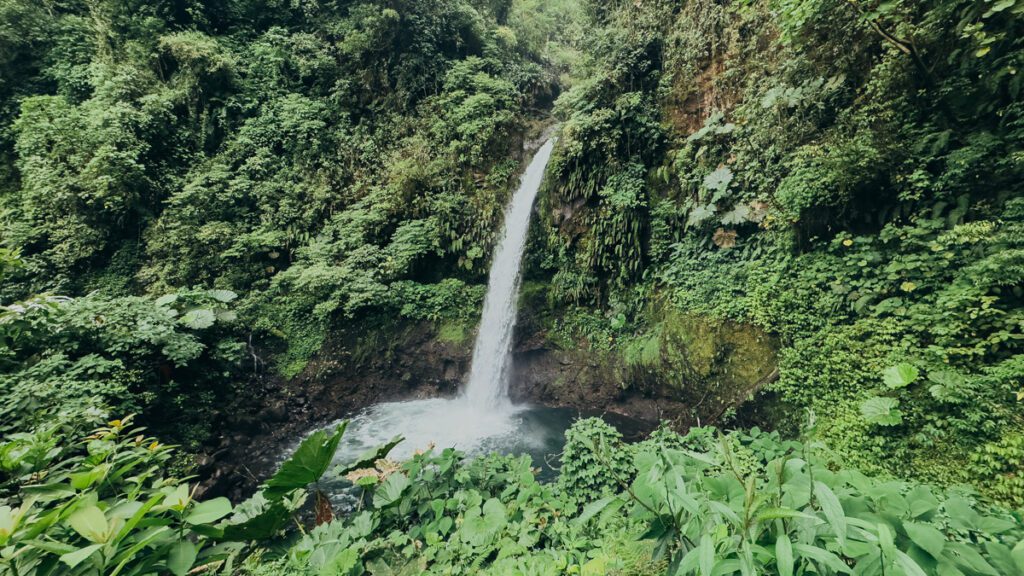
This article may contain affiliate/compensated links. For more information, please see our disclaimer here. We take all the efforts necessary to ensure the information included in this post is accurate, correct and current, sometimes, things just change! Travel information like opening hours, business operations and prices may change. If you find anything in this post that is incorrect or outdated, please let me know in the comments so I can update it for other readers. Cheers!
We love helping you plan amazing trips. If you need any of these services, consider booking them through our affiliate links. Without costing you anything extra, you will be helping support us so we can continue to write these blogs for you.
We thank you again for your continued support.
🏠 Find the perfect place to stay with Booking.com
✈️ Get the cheapest flights with Skyscanner
🚣 Book your favorite activities with Viator
💻 Make sure you have everything you need for your epic trip by checking our store on Amazon
Table of Contents
The 12 best waterfalls in Costa Rica
We want to help you discover some of the best falls in Costa Rica. We grouped them by location to help you plan the best itinerary possible so you can get the most out of your time in Costa Rica. Plus, we’ll include all the most relevant information for you here to help you plan the best trip possible.
Of course, we didn’t have a chance to explore all of them, but we did go to a majority of these waterfalls. We’ll let you know when it’s a fall we didn’t have the chance to see. But with some serious investigative work, we’ll let you know everything you need to know about those falls too!
Also, we’ll start with some of the lesser-known waterfalls. As always, we want to help you get off the beaten path and discover some of the hidden gems this country has (although there are fewer of them now that Costa Rica has turned into a massive tourist destination).
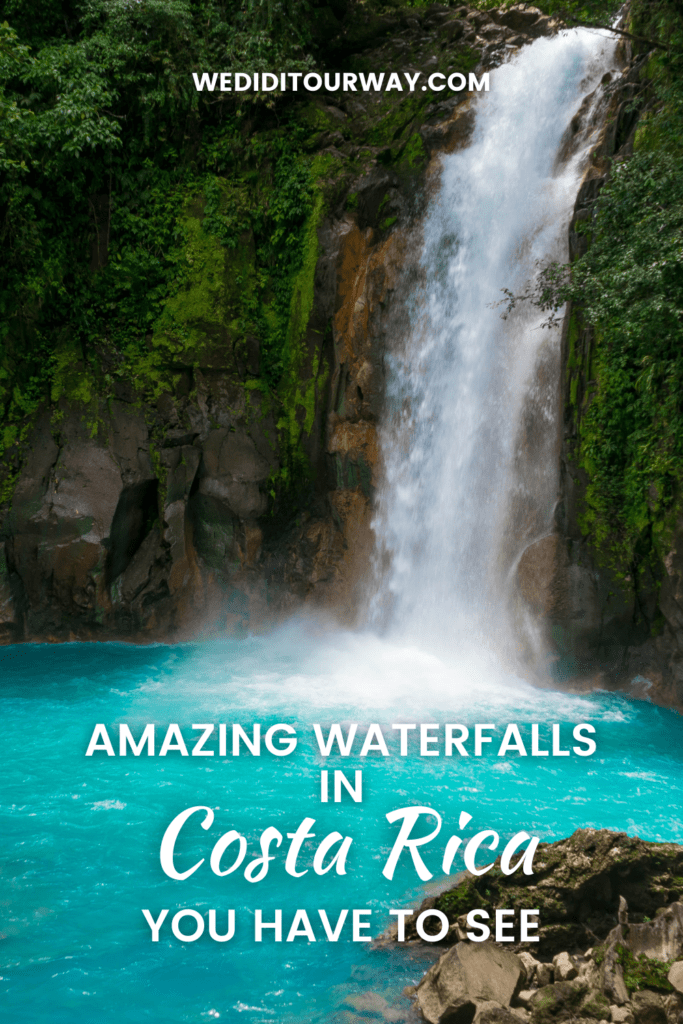
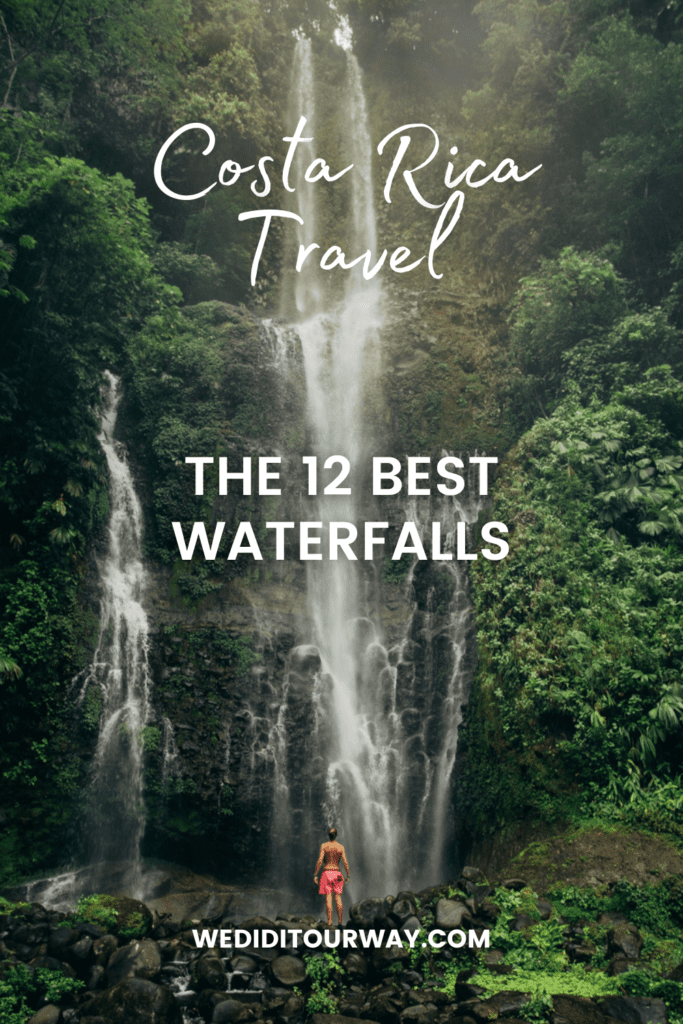
1. Catarata del Toro Waterfall, the tallest waterfall in Costa Rica
Located in the hidden gem region of Bajos del Toro, you’ll find the tallest Costa Rican waterfall – Catarata del Toro.
Standing tall at 91 meters, or 300 feet, Bajos del Toro fall is located in the Alajuela Province of the country. What’s great about this Costa Rican waterfall is that you can enjoy it from many different vantage points as the owners have created a beautiful atmosphere to enjoy it.
It is located on private property owned by a Dutch family. It costs $14 to enter the park and you’ll need about 1 hour to explore, depending on how fast you climb up and down the stairs, and how long you spend admiring this fall. The cascade descends into a volcanic crater, surrounded by dense rainforest. The area’s rich biodiversity really adds to the allure of this fall.
Since there are many vantage points to check out the Catarata del Toro, as much from the top as from the bottom, you can imagine that there are quite a few steps to go down! Luckily, the steps and the park as a whole are very well maintained. Although there are hundreds of steps, you can safely make it down there. Plus, you have a few benches along the way, as well as beautiful vantage points, so you can stop and take the view in!
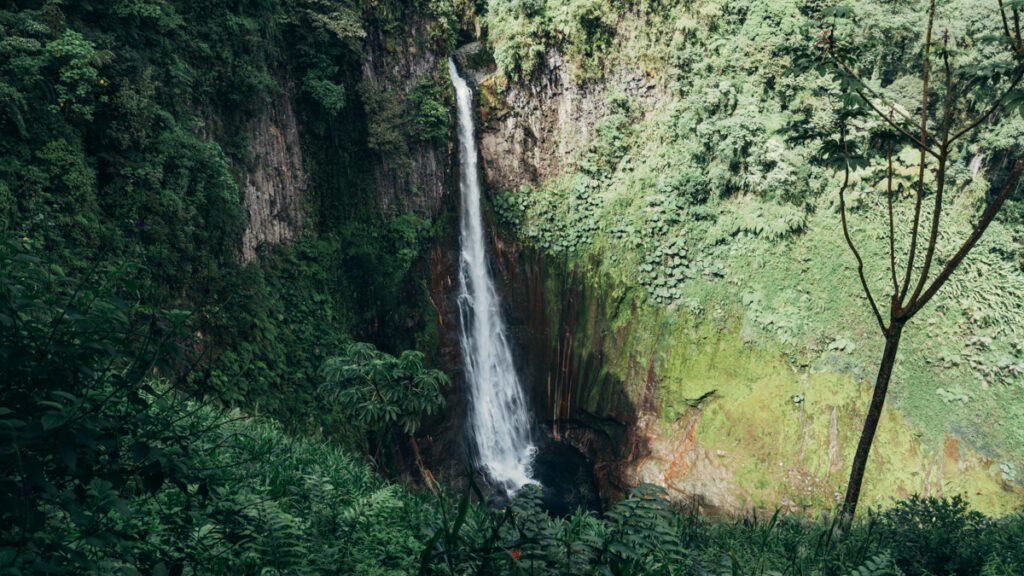
You cannot swim here, but as soon as you make it down the steps, you understand why – the sheer power of this Costa Rican waterfall is impressive enough! The current is way too strong for swimming here.
On-site, there is a parking lot, bathrooms, and a small restaurant. It was not open when we visited – the owners told us it was closed since Covid. But we were nice enough (and they were generous enough) that they decided to feed us anyway!
We recommend stopping at this waterfall in Costa Rica to enjoy the view and take in the beauty and power of this amazing place.
How to get to the Catarata del Toro and the other waterfalls in Bajos del Toro
Since the Bajos del Toro region is quite remote, the best way to get to these waterfalls is by renting a car or a campervan. We absolutely loved our experience with CostaRider Campervan. They have a great range of vehicles from family-sized to 4x4s and everything in between. It was a great way to explore the country on a road trip.
The route to get to the Catarata del Toro is paved, as is the whole route if you’re coming from San José or La Fortuna, so a 4×4 is not needed here. You’ll find this waterfall, as well as most of the other ones in Bajos del Toro on Route 708. You’ll notice signs all over the road pointing to various waterfalls.
This will apply for this waterfall and all the other falls located in the Bajos del Toro region.
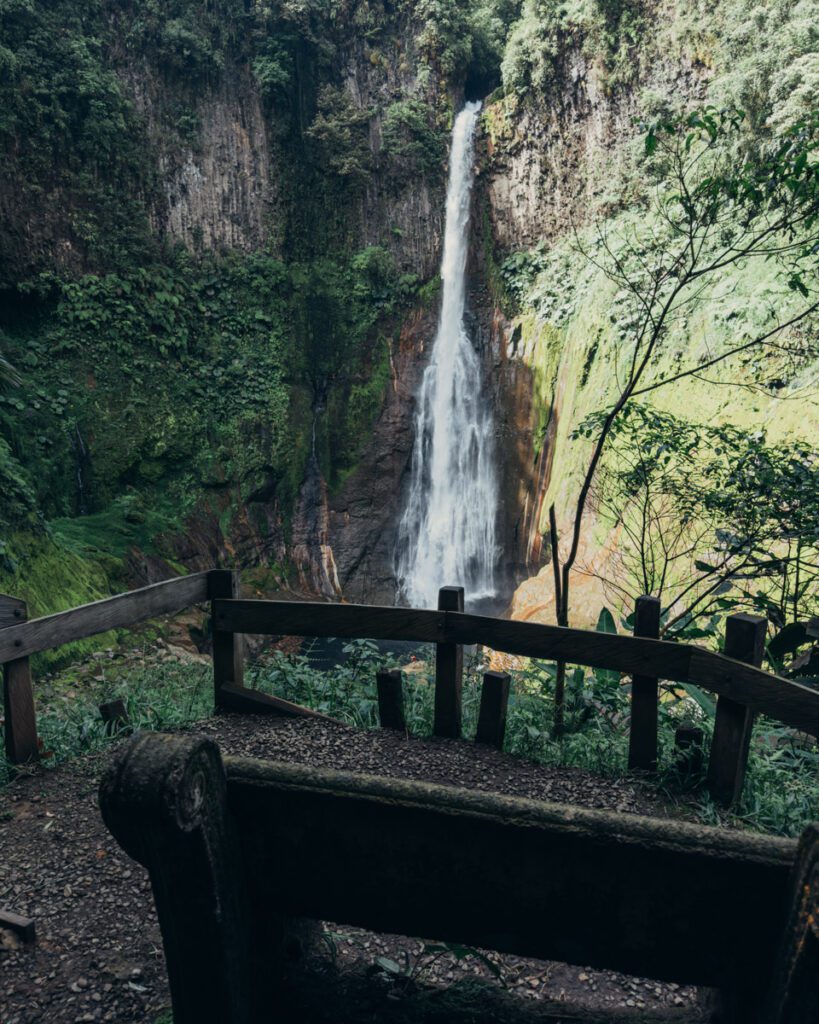
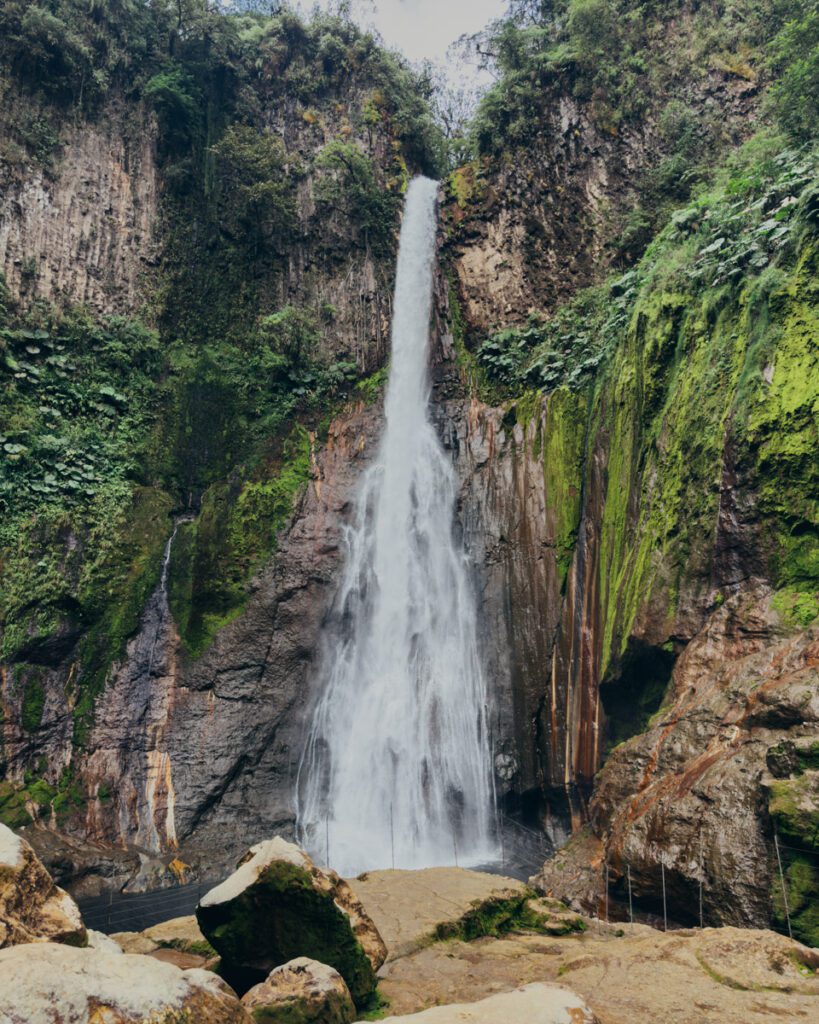
Where to stay in the Bajos del Toro region to explore Costa Rica’s best falls
To explore the Catarata del Toro and the other falls in the region, we recommend setting up camp in the Bajos del Toro region of Costa Rica. Luckily, there are plenty of accommodations here for all budgets and types of travelers.
Here is a short list of places you can book during your stay.
- Budget-friendly: Las Cabañas. Hospedaje Las Orquídeas
- Mid-range: Hotel Mango Valley. Selvática del Toro.
- Higher-end: El Silencio Lodge & Spa. Bosque de Paz Reserva Biologica.
What to do in the Bajos del Toro region
There are plenty of things to do while you’re staying in Bajos del Toro. Just on this list, you have a ton of other waterfalls you can explore. If you’re not too keen on seeing more water falling down rocks, we recommend you check our full Bajos del Toro guide.
As a summary, here are a few of the things to do in the area:
- Check out the national parks nearby, like Poás National Park, Juan Castro Blanco National Park and Carara National Park
- Relax at the different hot springs in the area
- Take a dip in the natural pools
- Get an adrenaline rush by going ziplining, rappelling down a waterfall or going canyoning
- Visit El Silencio Lodge to go for a mystic hike or a night walk, horseback riding, oxcart painting, and much more
- Visit one of the spas for a massage
There’s so much to do in Bajos del Toro, so if you’re staying nearby, you can enjoy all these activities. If not, you can stay in La Fortuna or in San José, and take a day trip from there.
ABOUT CATARATA DEL TORO
Location: Find it here on Google Maps
Official site
Entry cost: $14 USD for this waterfall alone, or $25 USD in a combo with the Blue Falls. Show them this coupon to get 15% off
Opening hours: Monday to Saturday: 7 am to 5 pm. Closed on Sundays
Amenities: Parking, bathrooms & seating area
Time needed: 45-60 minutes
Swimming allowed: No
What to pack: Hiking shoes (good sandals or sneakers will also work), camera
2. Blue Falls of Costa Rica, a set of 6 waterfalls in Bajos del Toro
The Blue Falls of Costa Rica are owned and operated by the same Dutch family as the Catarata del Toro. This set of 6 falls is located a few minutes’ drive away from the latter. If you plan on visiting, we recommend getting the combo ticket to both entrances so you can visit the 7 amazing waterfalls on this property in Bajos del Toro.
The Blue Falls have 6 waterfalls on the property as well as natural pools to hang out in. Be warned, the pools are extremely cold, even in the hottest months. Also, you should know that if it rains, you won’t be able to visit all the falls as some of them require you to cross rivers to get to them.
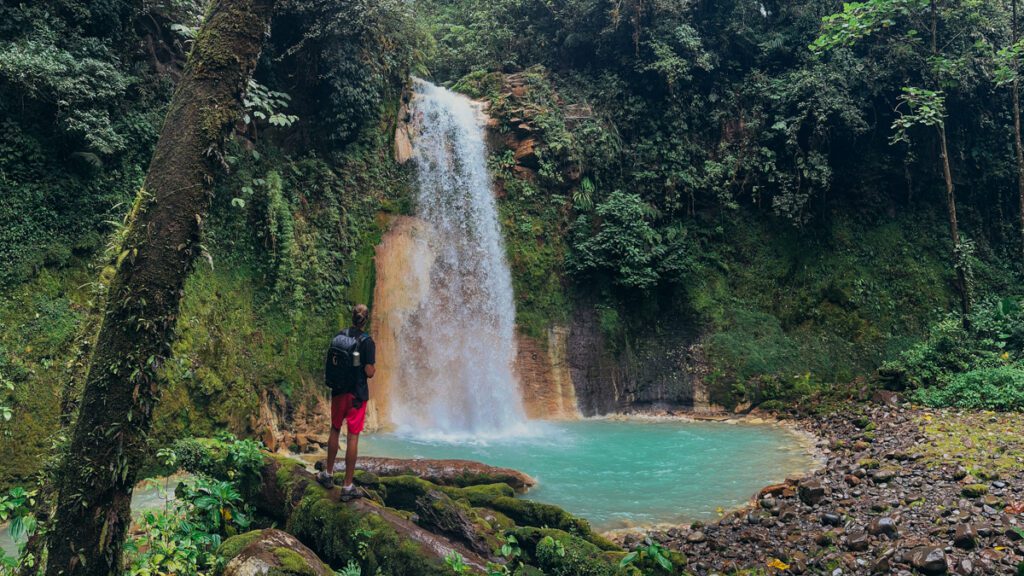
The entrance ticket for the Blue Falls can be purchased at the ticket office of the Catarata del Toro and it costs $15 USD, but the combo price is $25 USD. And if you show them this coupon, you get 15% off.
Although the property comes with a steep price as per Costa Rican standards, it is well-maintained and there are staff members available at various junctions and river crossings to assist you in navigating the terrain and avoiding any chance of getting lost.
The Blue Falls will require closer to 4-5 hours, depending on if you want to visit each of the falls, how long you spend at each one and if you choose to swim there. Again, if it rains, you won’t be able to visit them all. That’s why we recommend starting at the furthest one called El Tepezquintle, as it will likely close if it rains.
You don’t need to be in very good shape, but you should be in good health as there will be a lot of walking around. Also, as with most waterfalls, you’ll need to go up and down quite a few sets of stairs. You should also note that getting to the closest waterfalls will require you to walk a good 15 minutes before reaching them.
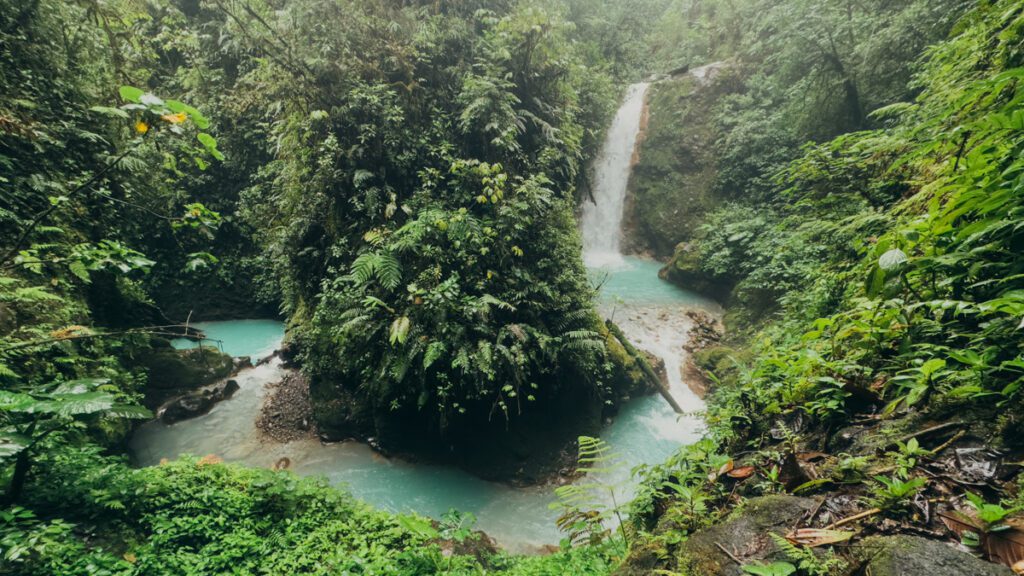
If you only have the time to visit one property for the waterfalls in Bajos del Toro, let this be the one you choose. For $15 USD, you get to see 6 amazing waterfalls and hang out in beautiful (but frigid cold) natural pools!
For the details on how to get to these falls, where to stay in Bajos del Toro and the other activities in the region, check what we previously wrote about the Catarata del Toro above.
ABOUT THE BLUE FALLS OF COSTA RICA
Location: Here on Google Maps
Official site
Entry cost: $15 USD or or $25 in a combo with the Catarata Del Toro. Show them this coupon to get 15% off
Opening hours: Open every day, except Sunday, from 7 am to 5 pm
Amenities: A parking lot. There are a few guides along the paths and junctions. No bathrooms
Time needed: 4-5 hours+
Swimming allowed: Yes, you can swim at some of the falls and there are natural pools too
What to pack: Hiking shoes, watershoes or sandals with velcro straps. Towel. Drinking water. Snacks. Rainjacket.
3. Tesoro Escondido, a locally treasured Costa Rican waterfall
Tesoro Escondido is not very well known by tourists (yet) but it is a locally loved waterfall in Costa Rica. Most Ticos who visit the Bajos del Toro region from San Jose come to this waterfall.
Tesoro Escondido means Hidden Treasure in Spanish, and its name is quite fitting. It’s a family-owned farm with a big waterfall on the property. The cost of the entrance is $15 USD per person. This gives you access to one very tall waterfall, a lookout point that is shaped like a droplet and many beautiful natural pools.
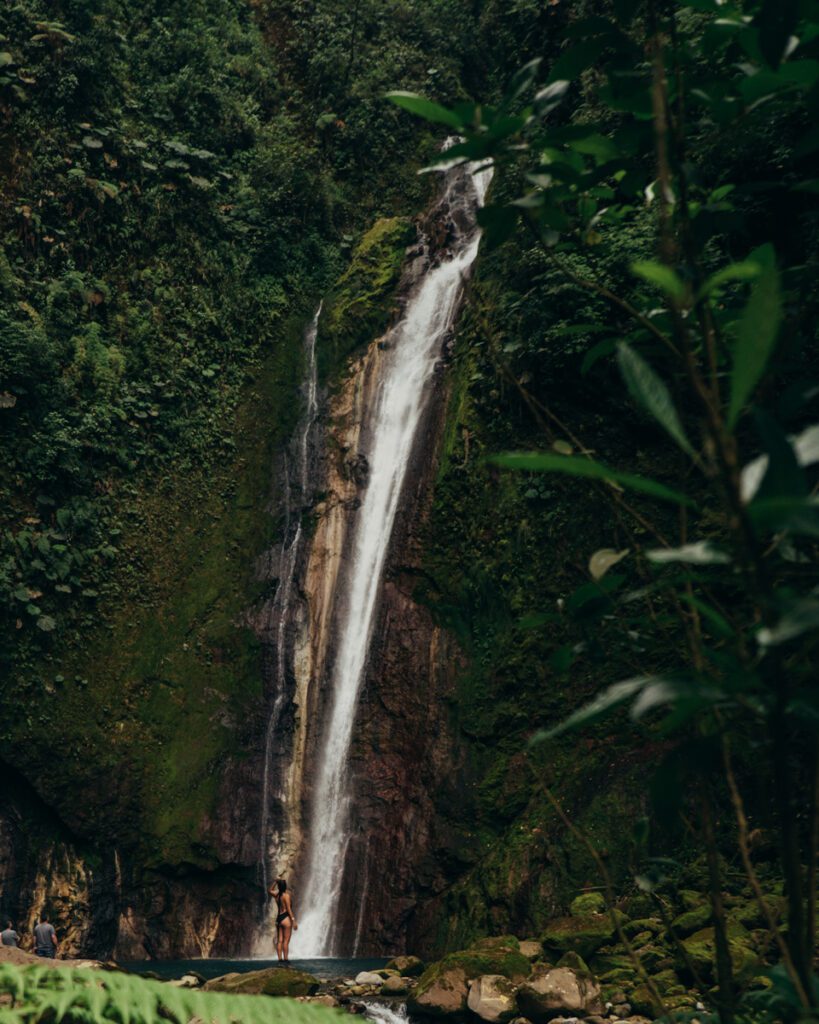
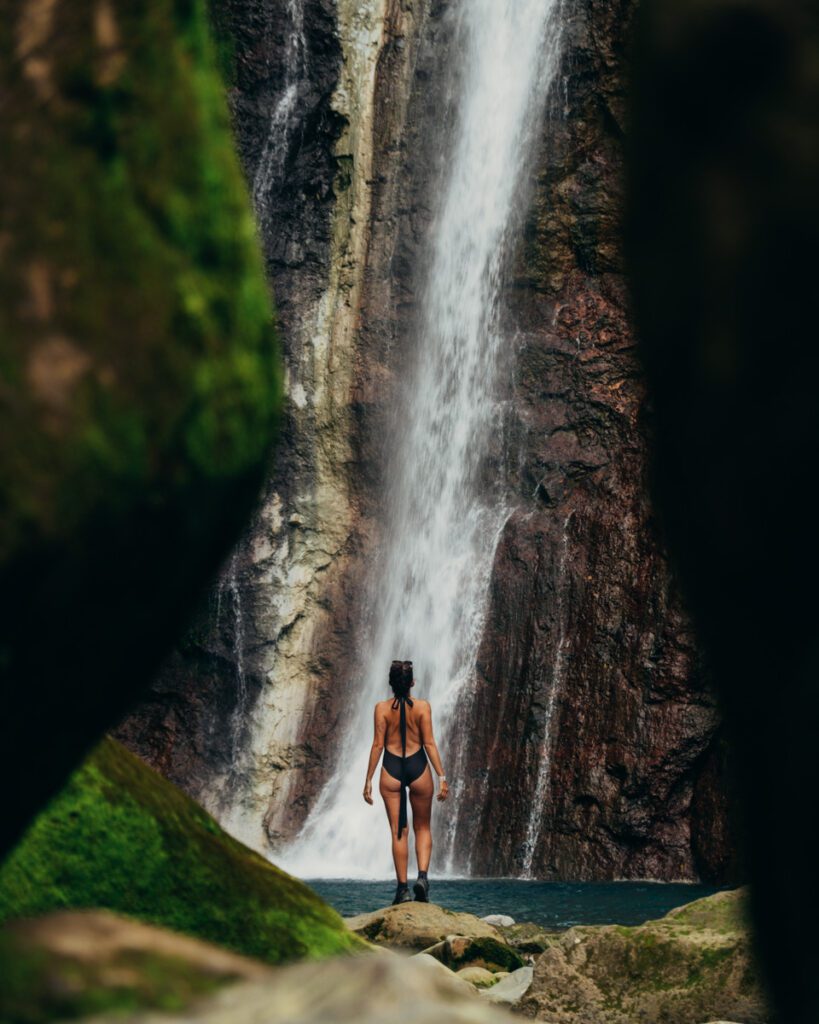
You’ll need about 1.5-2 hours on the site to explore it all. Of course, you may want more time if you’re going to lounge around in the pools (called Pozas in Spanish). As with many of the waterfalls in the region of Bajos del Toro, it’s important to know that if it rains, they will shut the property down. Since the waterfall feeds the rock pools, and the water levels rise quickly with rainfall, it’s best to visit these sites in the early morning, when you have less chance of rain.
This is a fairly easy waterfall to access. You still need to be able to walk through the forest and on rocky terrain, so we recommend you be in fairly good health to do it. There are also quite a few steps to go up and down if you want to go to the rock pools so keep that in mind as well.
If you want to spend a morning or an afternoon visiting a beautiful Costa Rican waterfall, and hanging out in rock pools, this is the place for you. It’s not well-known and you’ll likely have the place to yourself on weekdays. They also have bathrooms and showers, as well as some new options for accommodations.
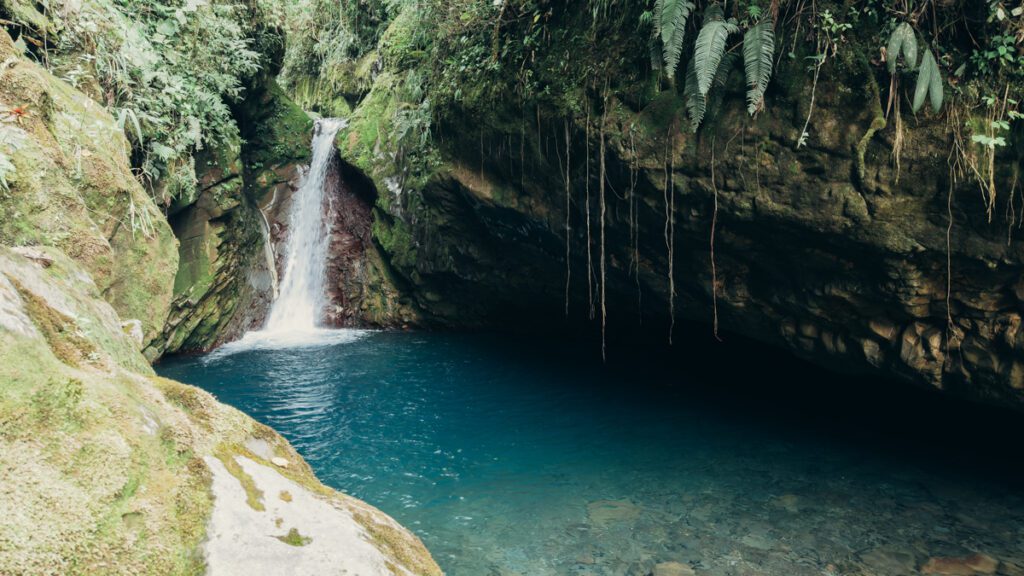
For details on how to get to these falls, where to stay in Bajos del Toro and the other activities in the region, check what we previously wrote about the Catarata del Toro above.
Note that it is possible to park a campervan on the property here and they do have a few accommodations available to rent as well. You can also access their restrooms, showers and covered shelter.
If you want to know more about getting to Tesoro Escondido waterfall, check out our full article here.
ABOUT TESORO ESCONDIDO WATERFALL
Location: Here on Google Maps
Official site (coming soon)
Entry cost: $15 USD
Opening hours: From 8 am to 3 pm on weekdays and 8 am to 4 pm on weekends
Amenities: Bathrooms & Showers at the entrance. Accommodations. Café-restaurant at the entrance.
Time needed: about 3 hours. More if you want to stay in the pools
Swimming allowed: Yes, you can swim at the waterfall and in the rock pools
What to pack: Sun protection. Watershoes or hiking shoes. Bathing suit. Towel. Water. Snacks.
4. Paraiso Manantiales, a family-owned waterfall in Costa Rica
Paraiso Manatiales is another family-owned property with about 8 waterfalls to explore. This site is not very well known by visitors – you can expect to mainly find locals here. It’s name means Paradise Springs in Spanish, and walking around the property, you’ll understand why.
You’ll need about 1.5-2 hours to explore all the waterfalls on the property and that time will vary greatly depending on how much time you spend swimming at the natural pool on site. The property is not very big, But there are a lot of cascades here. Most of the waterfalls are only for viewing. Overall, you have 6-8 waterfalls, depending on the season, as smaller ones sprout during the rainy season.
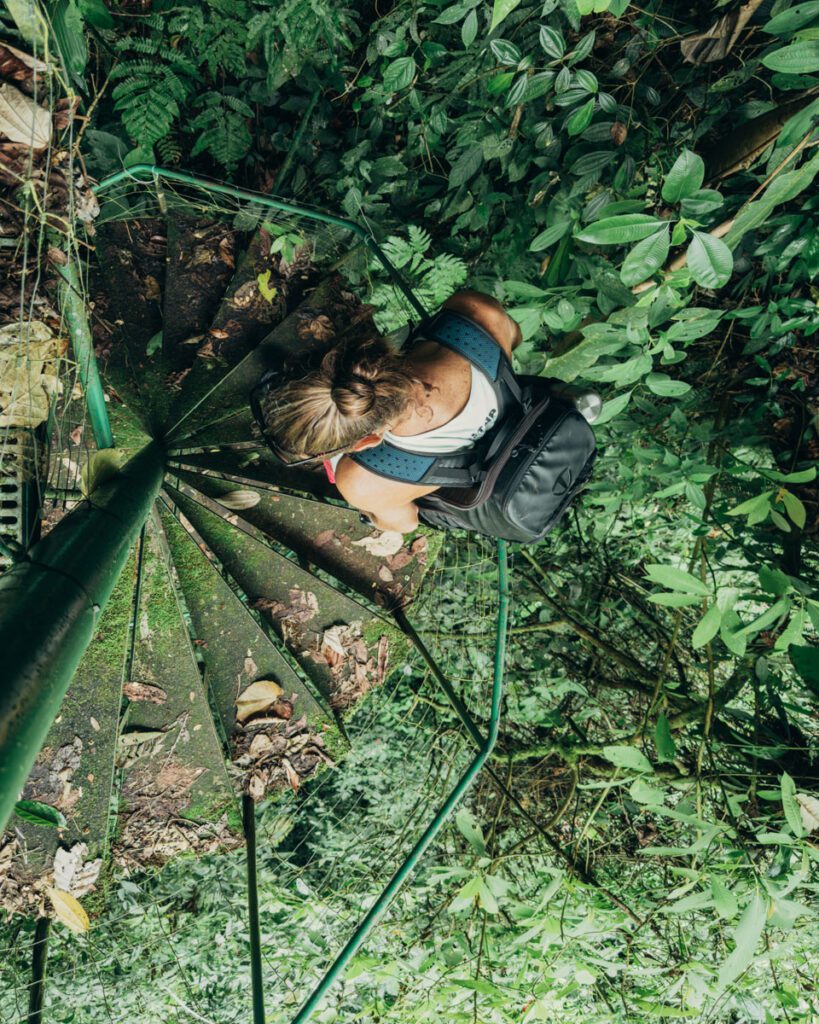
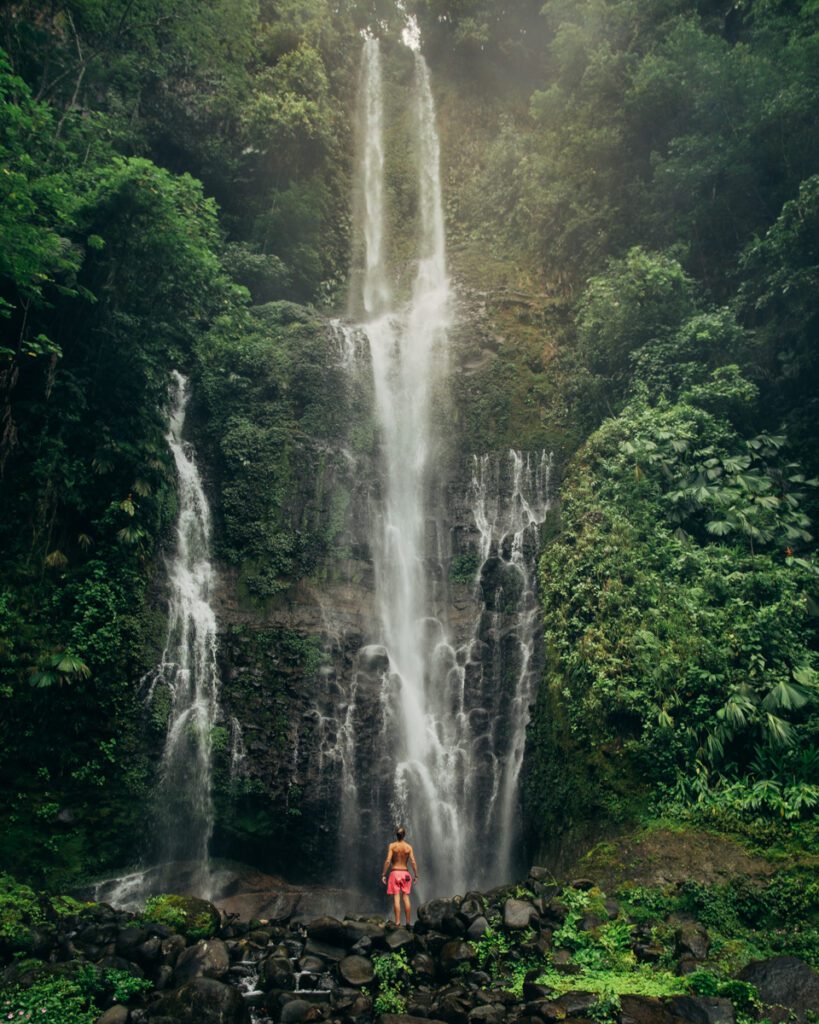
The trails on this property are fairly natural and are mainly located in the forest. You’ll need to go down a steep spiral staircase and walk a few hundred stairs (up and down) in the forest. We recommend being in good health to take full advantage of this property. We also recommend wearing good hiking shoes as it does tend to get muddy, especially in the rainy season.
There is also a lookout point with a cute handmade Pura Vida sign. You can take pictures here when you visit. There are 2 trails to go around the property. We recommend heading first to the mirador then going on the trail down to the largest waterfall and the natural pool. We did the opposite and had to walk the path twice.
Paraiso Manantiales also has a few cabins and campgrounds to rent if you want to stay overnight. There’s also a restaurant here, but they don’t serve any vegan or vegetarian options. Their dishes are mainly traditional local dishes that include chicken, pork or beef.
This is the perfect place if you’re looking to meet locals and get off the beaten path.
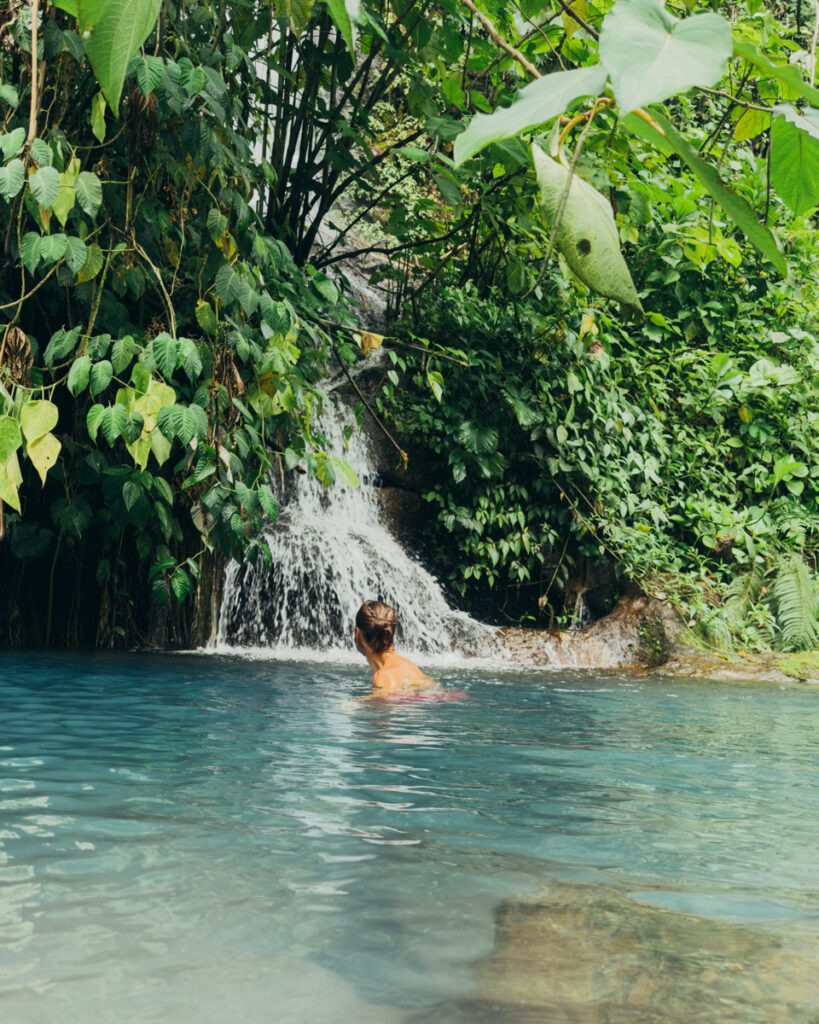
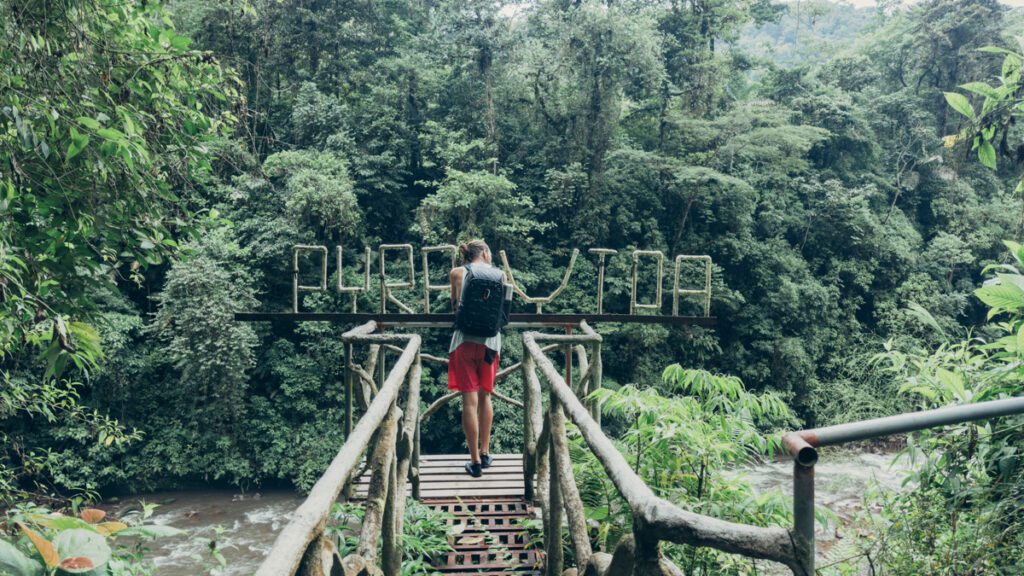
For the details on how to get to these falls, where to stay in Bajos del Toro and the other activities in the region, check what we previously wrote about the Catarata del Toro above.
Note that it is possible to park a campervan on the property here and they do have a few accommodations available to rent as well. You can also access their restrooms, showers and covered shelter.
ABOUT PARAISO MANANTIALES
Location: Here on Google Maps
Official site
Entry cost: $10 USD (cash only)
Opening hours: open every day from 8 am to 3 pm
Amenities: Bathrooms & cold showers at the entrance. Accommodations. Restaurant at the entrance. Overnight camping allowed for a fee.
Time needed: about 2 hours. More if you want to stay in the pool
Swimming allowed: Yes, you can swim at the natural pool, but not at the waterfalls
What to pack: Sun protection. Insect repellent. Watershoes or hiking shoes. Bathing suit. Towel. Water. Snacks.
5. Vuelta del Cañon waterfall, an amazing waterfall hike in Costa Rica
This is the final waterfall we visited in Bajos del Toro during our road trip around Costa Rica. It’s another family-owned farm with a big waterfall on the property. Did we tell you pretty much everyone has a waterfall on their property in Bajos del Toro? It may very well be the waterfall capital of the world (or at least Costa Rica!)
We recommend starting this hike early in the morning, as it is quite a hike to get here and you won’t be able to make it if it starts to rain. Again, there are quite a few river crossings on this hike. And to be honest with you, the whole access part and the trail are a bit sketchy.
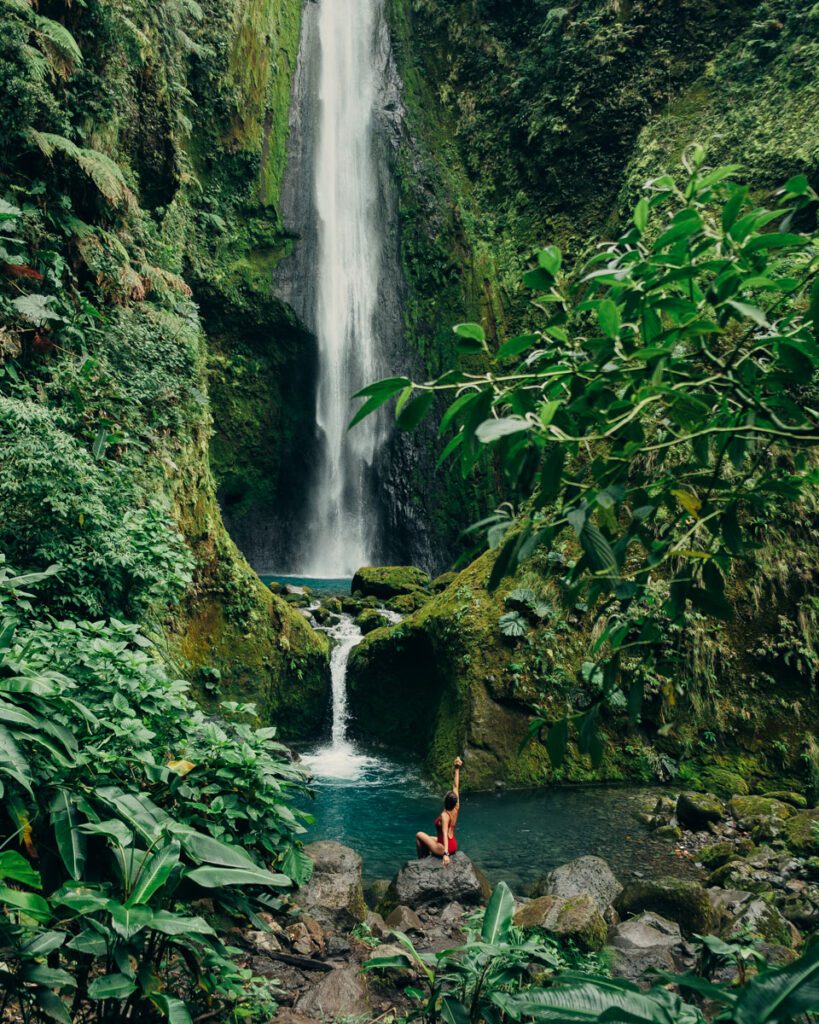
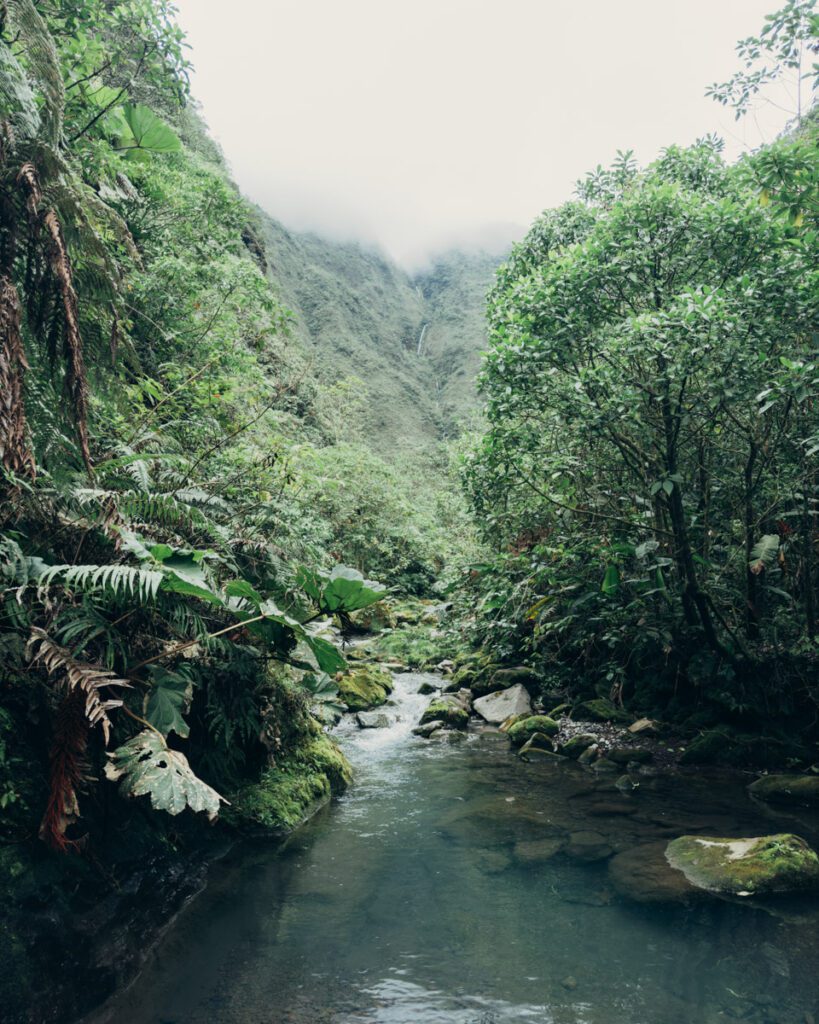
To access this hike, there’s a parking lot about 50m away from the entrance. You have signs pointing to both on the road. When we arrived, there was no one at the parking lot so we made our way to the entrance which is kind of like walking into a little town with houses on both sides of the road. There, we were stopped by a man who we presumed was the owner and we paid him.
To get here, you have to be in good physical health. This is quite a long hike and although there isn’t any elevation gain, you do have to walk for about 1.5 to 2 hours each way, crossing rivers about a dozen times. Also, the last stretch of the hike is through the river where, at the deepest point, you will be waist-deep. Make sure you have a waterproof bag as you can slip and fall in the water quite easily. It may have happened to one of us!
You can also choose to take a dip in this river as the water is quite refreshing, especially on hot days. If not, there is only 1 big waterfall to see here although it is on 2 levels.
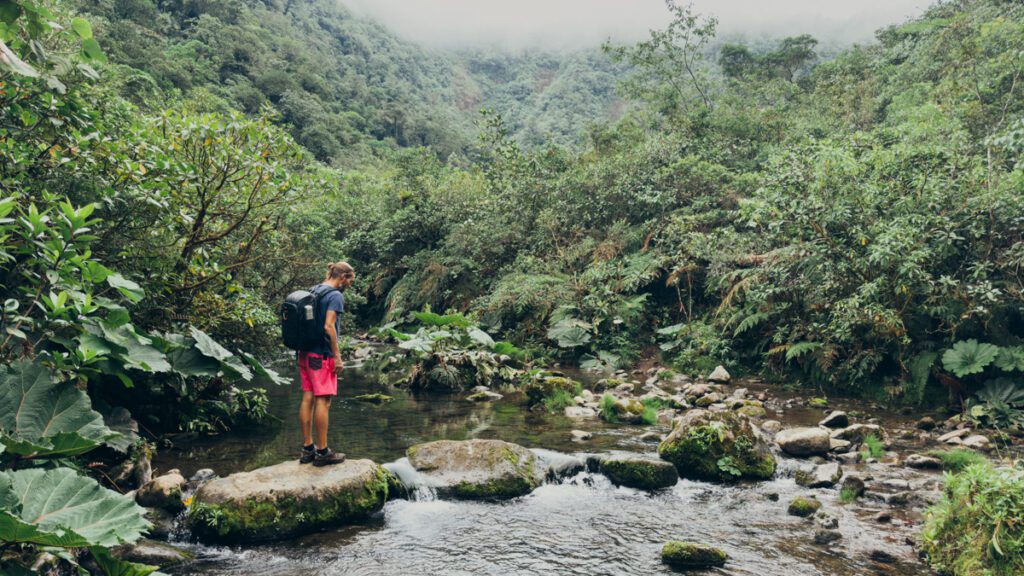
It’s best to start this hike very early, around 7-8 am, especially in the rainy season. Because you have to cross the river so many times, you can’t do this hike if it’s raining as the river risks flooding. Also, note that you can also do this hike with guides. Even if the trail is marked, you can sometimes not spot the red ribbons hanging on trees that mark the trail.
You can also camp on the property’s parking lot where they have a few showers and a bathroom available. There is also a covered area with picnic tables available where you can set up camp.
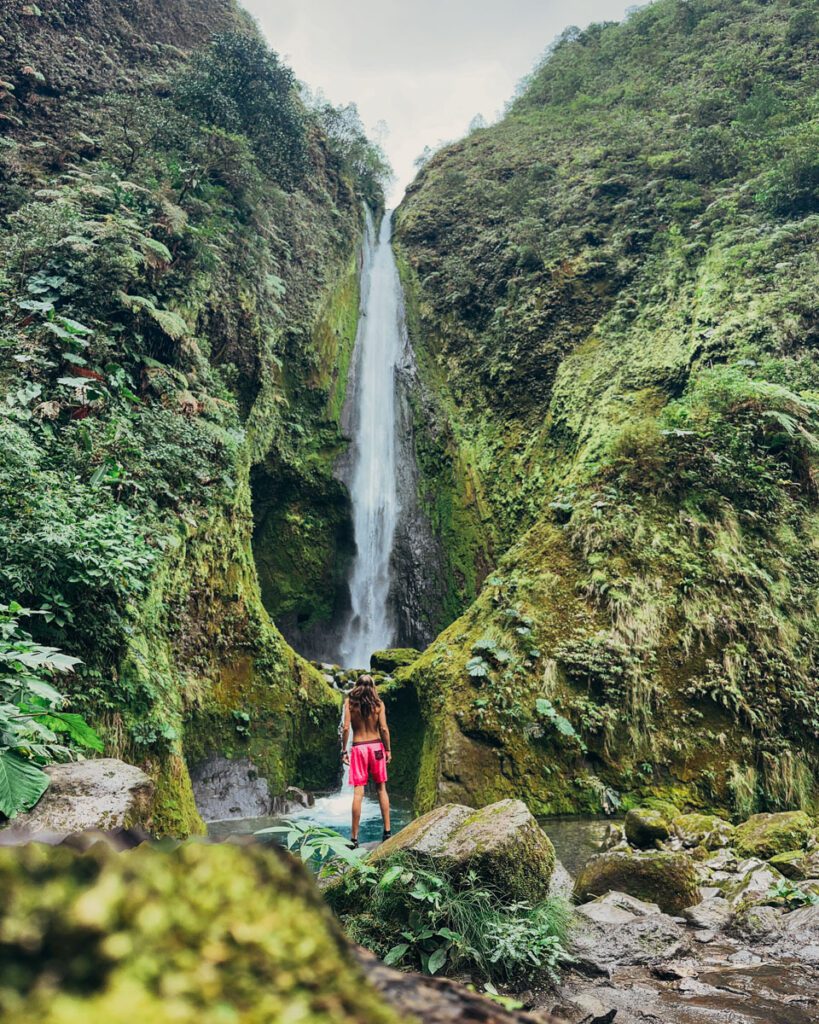
For the details on how to get to these falls, where to stay in Bajos del Toro and the other activities in the region, check what we previously wrote about the Catarata del Toro above.
Note that it is possible to park a campervan on the property here. You can also access their restrooms, showers and covered shelter.
ABOUT THE VUELTA DEL CANON WATERFALL
Location: Here on Google Maps
Official site
Entry cost: $16 USD (cash only)
Opening hours: Open every day. There are no hours of operation, but we recommend starting early
Amenities: Bathrooms & cold showers at the entrance. Overnight camping allowed for a fee.
Time needed: about 5 hours for the hike and hanging out at the waterfall.
Swimming allowed: Yes, you can swim at bottom of the waterfall, but the water is cold
What to pack: Sun protection. Insect repellent. Watershoes or hiking shoes – your feet will get wet as you have to cross the river many times. Bathing suit. Towel. Water. Snacks. Waterproof bag.
6. Nauyaca Waterfalls, the most popular waterfalls in Costa Rica
The Nauyaca waterfall is probably one of the most popular ones in the country. Not only is it located fairly close to Manuel Antonio National Park, the most popular national park in Costa Rica, but it’s also a frequent stop on most visitor’s road trip itineraries.
The Nauyaca Waterfalls are located at the foothills of the Talamanca Mountains, near the village of Platanillo, not too far from Dominical and Uvita. They are a part of a private nature reserve and there are 2 different access points to the falls. Each one is operated by a different company. We visited using the Nauyaca Waterfalls entrance.
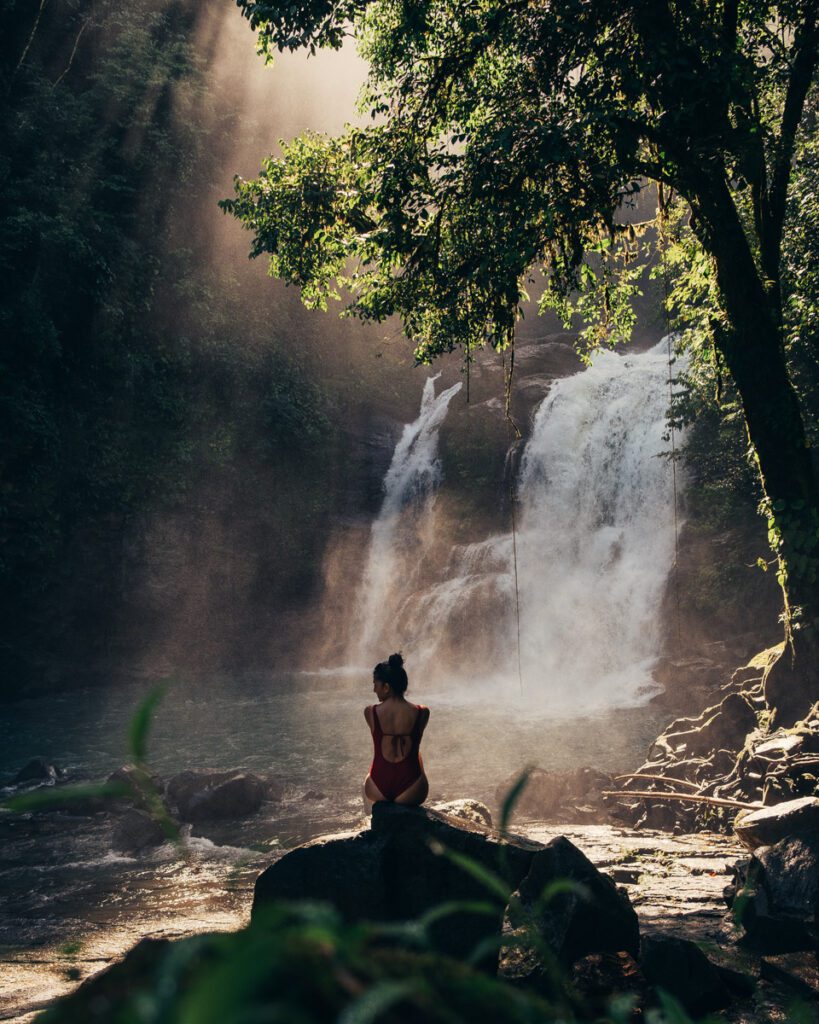
There are many different ways to get there. First, you have to purchase your tickets at the office located on the main road. Then, you can drive down to the parking lot. From there, you can hike down to the falls, which will take about 1-1.5 hours. You can also choose to take a ride on a 4×4 or go on horseback. Derek was injured when we went, so we chose the 4×4 option. It was pricey, but well worth it since it was sunny, hot and humid on that particular day.
This Costa Rican waterfall has 2 main sections – The upper falls and the lower falls. The first set at the top is about 45 meters high (148 feet) and the lower ones are 20 meters high (or 66 feet). You can’t swim at the top falls, but you can take a dip in the bottom falls. There are many rock pools where you can wade in the water. But be warned, the current can get quite strong, especially in the rainy season.
Whether you choose to hike or take a ride, we recommend wearing good shoes as you will need to go down a few steps to make it to the falls. Water shoes are also good for getting in the water. Also, sun protection is a must.
Make sure you take the time to visit both sections of the falls as each one is beautiful and powerful in its own way.
Although these waterfalls in Costa Rica are quite popular, they are also very beautiful and despite the high price tag, they are very much worth visiting, especially if you’re only in the country for a short while and want to see the highlights.
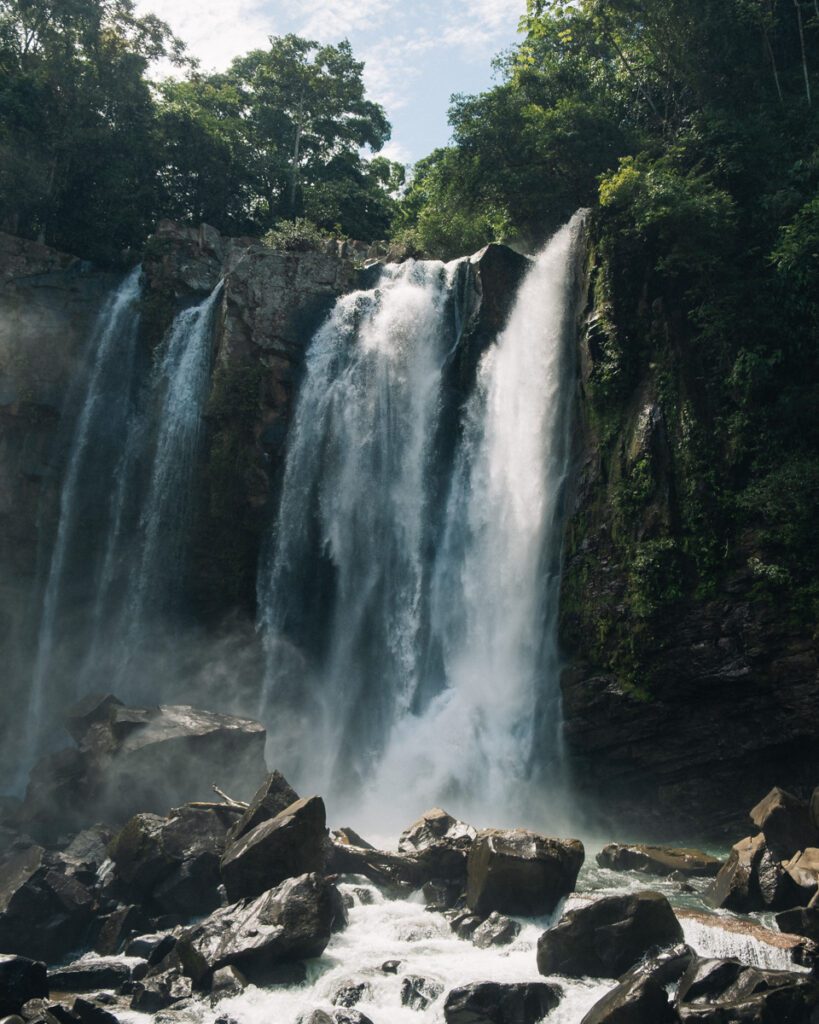
How to get to Nauyaca Waterfall
Just like the Bajos Del Toro waterfalls, we highly recommend renting a car or a campervan to get around more easily. A highlight of our time in Costa Rica was going around in our CostaRider campervan.
However, if you don’t want to rent a car, there are many tours that can take you to these waterfalls as well as a few other hotspots around. If that’s more your jam, take a look at these different tour options
Where to stay near the Nauyaca Waterfall
Located near Uvita and Dominical (and a slightly longer drive from Quepos or Manuel Antonio), there are plenty of accommodations to choose from when visiting the Nauyaca Waterfalls. There’s something for everyone and every budget. And for those who are driving around in a campervan, Dominical is a great beach where you can camp for free.
If you’re looking for other types of accommodations, here are a few options:
- Budget-friendly: Iguana Libre. Hotel Tropical Sands Dominical. Bamboo River House and Hotel.
- Mid-range: Hona Beach Hotel. Tree of life Cabañas. Hotel Cuna del Angel.
- Luxury: Pacific Edge Eco Lodge. Lapazul Boutique Hotel.
What to do near the Nauyaca Waterfall
There are plenty of things to do near Nauyaca, especially if you plan on staying a few days in the area during your Costa Rica trip. If you’re a nature-lover, you’re in luck, because the great outdoors are your playground here.
Here’s a short list of things you can do in the area:
- Visit some of the most beautiful beaches in Central America: Uvita or Dominical
- Check out the best national parks in Costa Rica: Manuel Antonio, Marino Ballena
- Head out to some other waterfalls (see below)
- Eat to your heart’s content in the bigger towns like Uvita and Dominical
- Go on a day trip out to Cano Island or go whale-watching if it’s the season
This is only a short list of things you can do in the area! There’s a ton more still!
ABOUT THE NAUYACA WATERFALL
Location: Here on Google Maps
Official site
Entry cost: $10 USD for hiking. $32 for the 4×4. $80 for the horseback riding tour
Opening hours: Monday to Saturday: 7 am to 2 pm. Sunday from 8 am to 2 pm
Amenities: Bathrooms & cold showers at the parking lot
Time needed: About 1-2 hours at the waterfalls, depending on how much time you want to stay there
Swimming allowed: Yes, you can swim at bottom of the lower waterfall
What to pack: Sun protection. Insect repellent. Watershoes and hiking shoes. Bathing suit. Towel. Water. Snacks. Waterproof bag.
7. Uvita Waterfall, a unique waterfall in Costa Rica
If you’re looking for fun and adventure and a truly unique waterfall to explore in Costa Rica, Uvita is the one you should head to. Although this waterfall is not very tall, it has something very special about it!
Located in the town of Uvita, about a 10-minute drive from the center, this waterfall is great for a morning or an afternoon of fun. You’ll need to hike down a short trail before you arrive at this watering hole with a beautiful waterfall at the end of it. You will notice a ladder to the side of the waterfall and people may be climbing up it. And as you know, what goes up, must come down! And that’s what makes Uvita Waterfall so unique. It’s a natural toboggan!
It may seem scary at first, but sit at the edge of the fall, keep your chin to your chest, cross your arms on your chest, cross your feet at your ankles and slide down. You’ll simply slip down the waterfall and dive into the water.
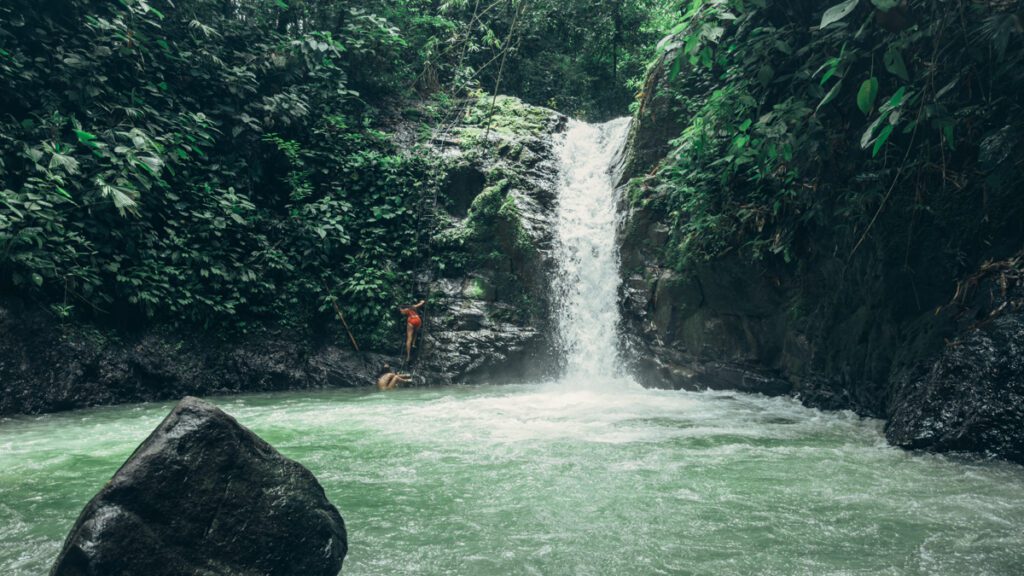
If that’s not your thing, you can also hang out in the water under the fall and watch people slide down. Just be warned that the water is cold and the current is strong. Swimming to get to the ladder is a tough one!
If you don’t want to do that either, there are other natural pools further down the river where the current is much softer. There’s also a 3-meter-high platform you can jump from.
It’s important to note that there are 2 different entrances to the Uvita waterfall. The first one is lower down the hill and charges a bit more to enter, but you have access to the butterfly farm there. The second one is further up and has a small restaurant where you can grab a bite to eat. You’ll need to walk down further to get to the waterfall from here, but you’ll also need to climb these stairs back up.
You can spend a good 2-3 hours here, and you can keep going down the waterfall or jump off the platform as many times as you want. You can also relax in the natural pool. Overall, it’s a great place to spend half a day! After that, you can easily head to the town of Uvita, and explore the Marino Ballena National Park, it’s another unique park in Costa Rica.
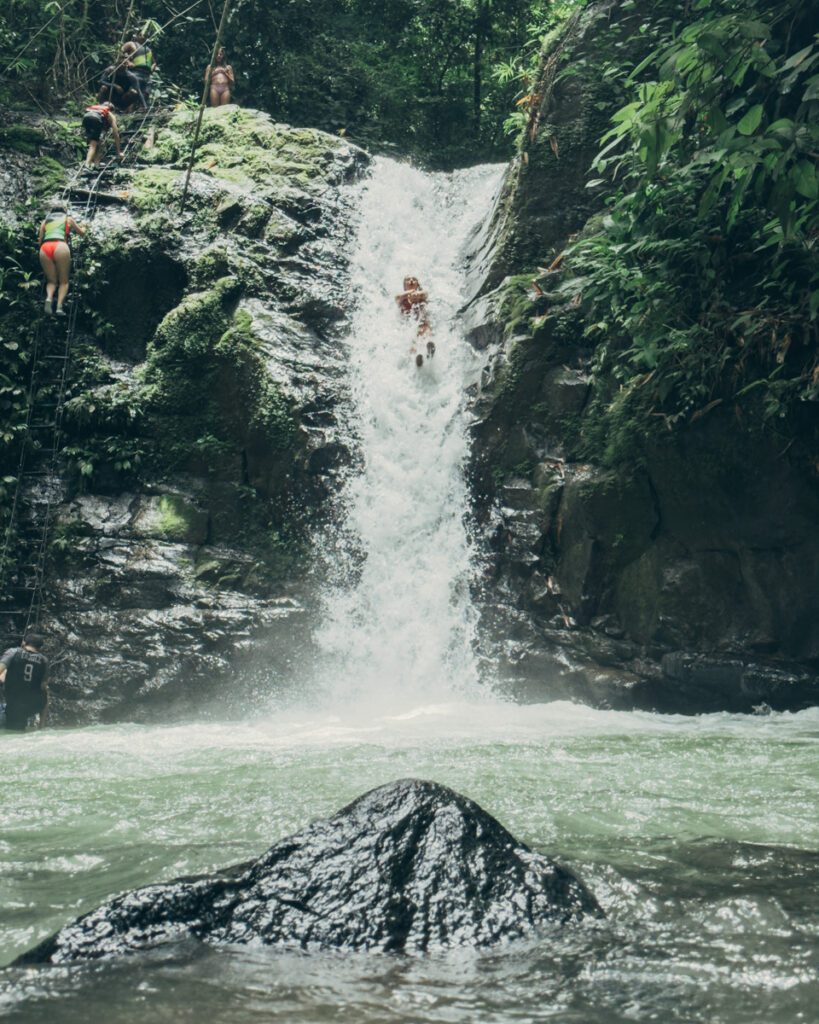
How to get to Uvita Waterfall
Getting to the Uvita waterfall is quite easy and straightforward. Simply follow the directions from Google to get there. The road isn’t paved in some parts, but you don’t need a 4×4 to get there. Just go slow and steady with your rental car.
There are also plenty of tour companies that offer guided expeditions to the Uvita waterfalls as well as some lesser-known falls in the area. If you want to meet new people and discover hidden gems, this is a great way to explore the different waterfalls in Costa Rica.
Where to stay near the Uvita Waterfall
Uvita is a fairly large town on the coast of Costa Rica. It’s not too far from San José or from the famous national parks in the area. If you want to set up camp in Uvita, you have a large variety of accommodations to choose from. Here are a few that stood out to us as having a great rating as well as good pricing.
- Budget-friendly: Luminosa Uvita. Flutterby House. Tropical Beach.
- Mid-Range accommodations: Ballena Rey Hotel. Ibiza Tropical Beach Villa. Seren Glamping.
- Luxury experiences: Alborada Boutique. Cristal Ballena Boutique Hotel & Spa. Cabinas El Paso de Moises.
What to do near the Uvita Waterfall
There are plenty of things to do in and around Uvita, especially if you plan on staying a few days in the area during your Costa Rica trip. Uvita is a great place to hang out for a few days and take in the sights.
Here’s a short list of things you can do in the area:
- Visit some of the most beautiful beaches in Central America: Uvita or Dominical
- Check out the best national parks in Costa Rica: Manuel Antonio or Marino Ballena
- Head out to some other waterfalls (see below)
- Go on a day trip out to Cano Island or go whale-watching if it’s the season
This is only a short list of things you can do in the area! There’s a ton more still!
ABOUT UVITA WATERFALL
Location: Here on Google Maps
Official site: None
Entry cost: $3 USD if you go to the top entrance. $4 at the lower entrance
Opening hours: Open every day, from 8 am to 5 pm
Amenities: Bathrooms at the entrance
Time needed: about 2-3 hours.
Swimming allowed: Yes, you can swim at bottom of the waterfall, and in the rock pools
What to pack: Sun protection. Watershoes. Bathing suit. Towel. Water. Snacks. Waterproof bag.
8. Uvita Secret Waterfall, a local hidden gem of a waterfall in Costa Rica
We’re going to be a bit secretive about this Costa Rican waterfall near Uvita. It’s a local hidden gem, and we want to keep it that way! We still wanted to include it on our list because it’s a really great waterfall. Its location is noted on Google (we didn’t put it there, promise!)
Not too far from the paid Uvita waterfall, you have another waterfall. Apparently, there’s a third one too, but we’ll let you dig deeper to find that one!
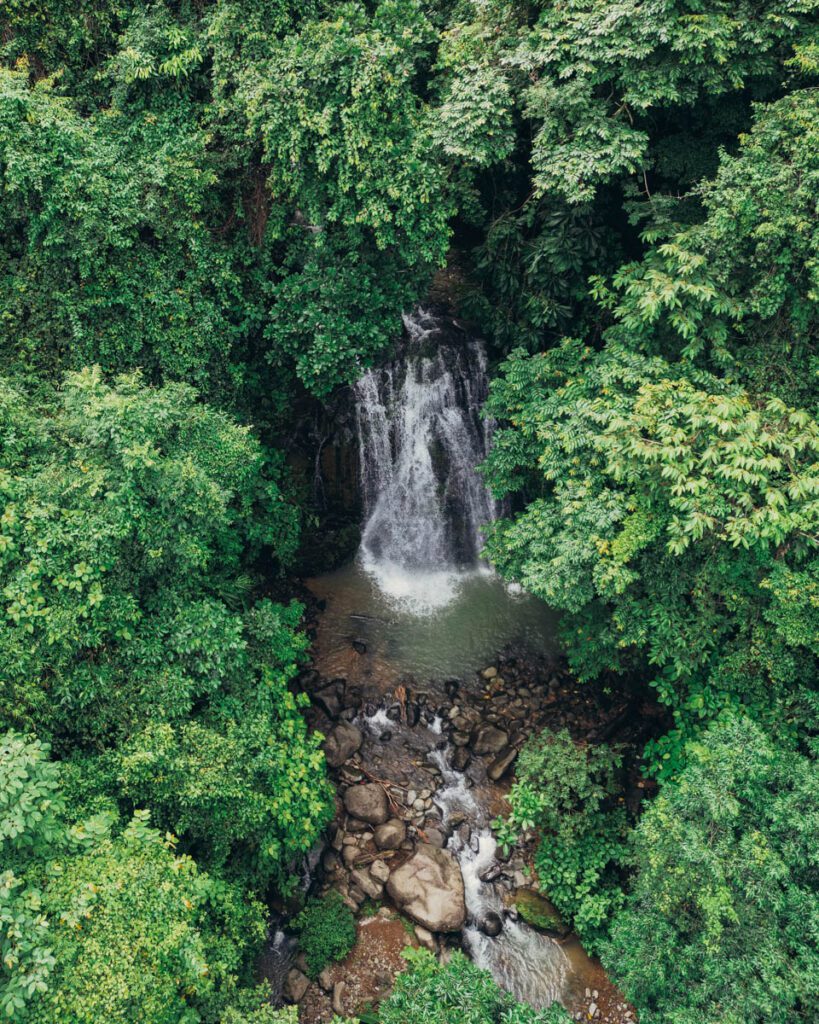
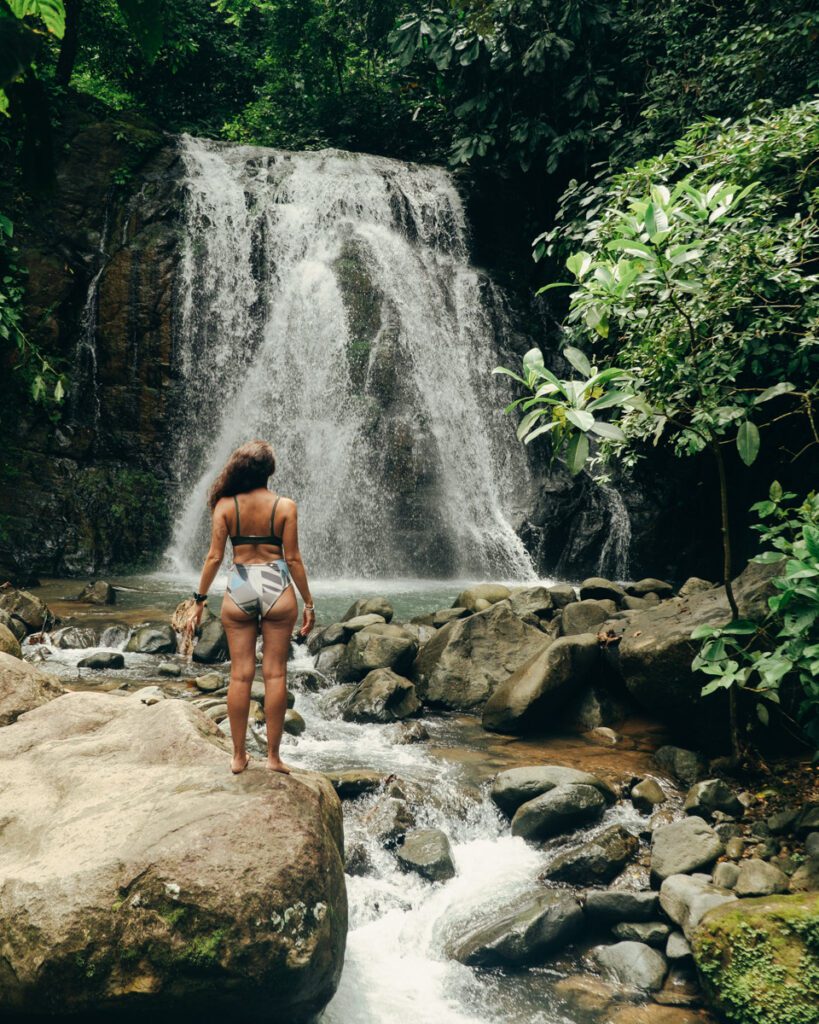
This waterfall is hidden in the forest and you have to cross a river to get to it. Well, actually, you have to cross 2 rivers to get to the actual waterfall, but the second river has natural pools and even if you don’t make it to the waterfall, the river itself is pretty nice and fun to explore.
After your 2 river crossings, you’ll get to this beautiful waterfall surrounded by lush vegetation. We went in the wet season, so the waterfall was abundant and the forest was green and lush. It was absolutely stunning.
Since it is not on the tourist trail, you will likely be the only person there. Take your time and enjoy the beauty here. Bring a snack, bring some water, and a book and just chill out! Make sure you bring your trash back with you!
How to get to Uvita’s Secret Waterfall
Getting to the Secret Uvita waterfall is quite easy and straightforward. Simply follow the directions from Google to get there. The road isn’t paved and is quite bumpy in certain parts, but you don’t need a 4×4 to get there. Just go slow and steady with your rental car. Also, as we mentioned, you need to cross a river to get there – don’t attempt to do it with your car, even if it is a 4×4. The river is too deep and too rocky. Just cross by foot.
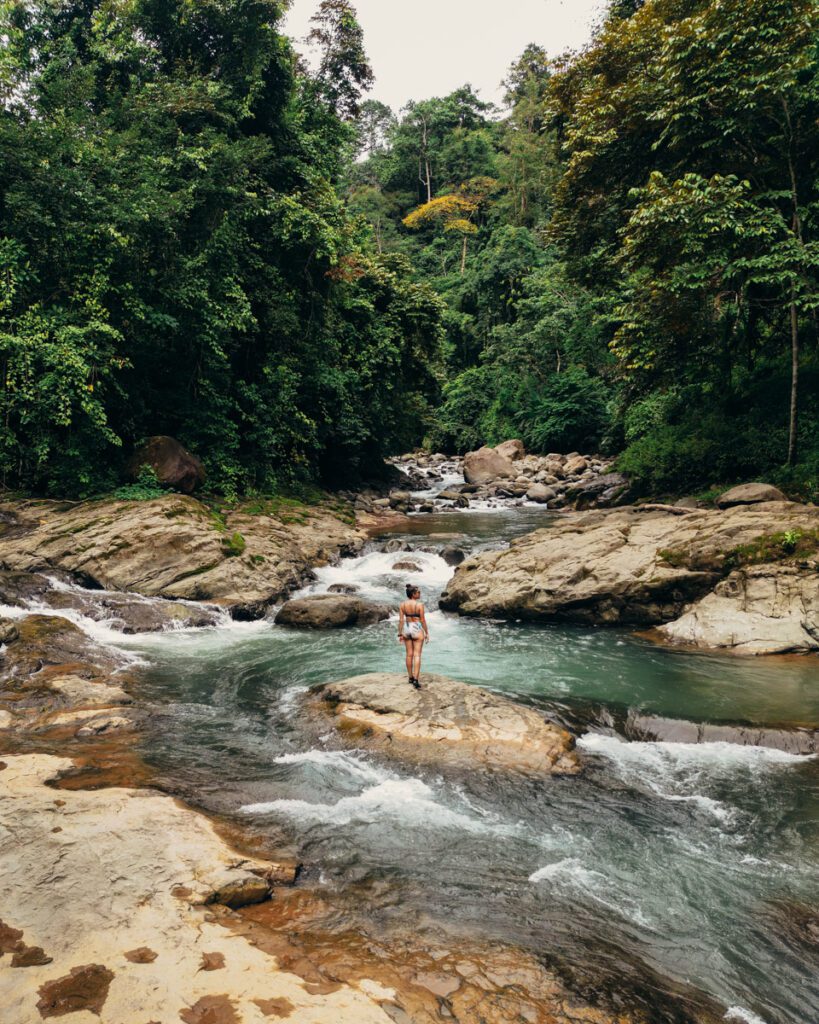
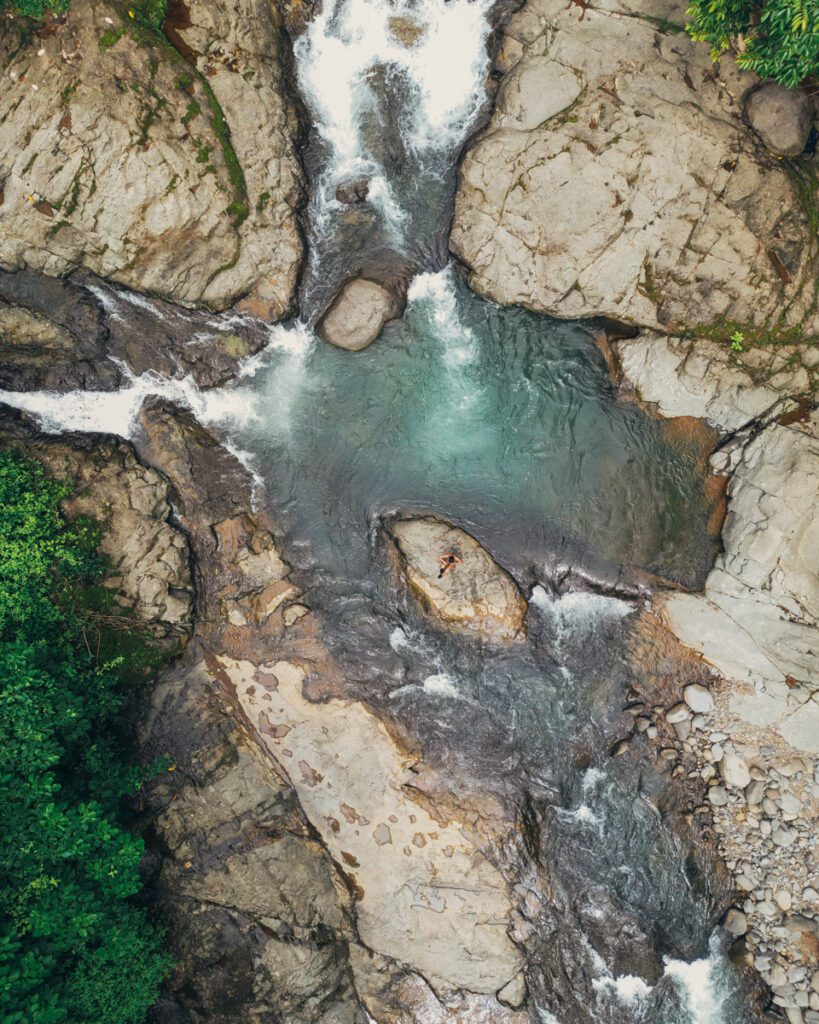
Where to stay near Uvita’s Secret Waterfall
Uvita is this pretty big town on the Costa Rican coast. It’s not too far from San José or some awesome national parks around. If you’re thinking of crashing in Uvita, you’ve got tons of cool places to do so. We found a couple with awesome reviews and great prices that you might like.
- Budget-friendly: Luminosa Uvita. Flutterby House. Tropical Beach.
- Mid-Range accommodations: Ballena Rey Hotel. Ibiza Tropical Beach Villa. Seren Glamping.
- Luxury experiences: Alborada Boutique. Cristal Ballena Boutique Hotel & Spa. Cabinas El Paso de Moises.
What to do near Uvita’s Secret Waterfall
There are plenty of things to do in and around Uvita, especially if you plan on staying a few days in the area during your Costa Rica trip. Uvita is a great place to hang out for a few days and take in the sights.
Here’s a short list of things you can do in the area:
- Visit some of the most beautiful beaches in Central America: Uvita or Dominical
- Check out the best national parks in Costa Rica: Manuel Antonio or Marino Ballena
- Head out to some other waterfalls (see previous)
- Go on a day trip out to Caño Island or go whale-watching if it’s the season
This is only a short list of things you can do in the area! There’s a ton more still!
ABOUT THE UVITA SECRET WATERFALL
Location: Here on Google Maps
Official site: None
Entry cost: Free
Opening hours: Open every day. There are no hours of operation
Amenities: None
Time needed: About 2-3 hours. Take your time and enjoy it
Swimming allowed: Yes, you can swim at bottom of the waterfall and in the natural pools
What to pack: Sun protection. Insect repellent. Watershoes. Bathing suit. Towel. Water. Snacks. Waterproof bag.
9. La Fortuna waterfall close to Arenal Volcano
La Fortuna waterfall may be the second most popular waterfall in Costa Rica… Or the first. Official numbers are never released so it is hard to tell, but we know that both Nauyaca and La Fortuna are popular tourist destinations for those who come to Costa Rica for one week or more.
The La Fortuna Waterfall is located in the Alajuela province, in the town that bears the same name – La Fortuna. It’s situated at the base of Arenal volcano, in the National Park which also bears its same name. It’s also one of the most popular national parks in Costa Rica, well worth the visit if you’re coming this way!
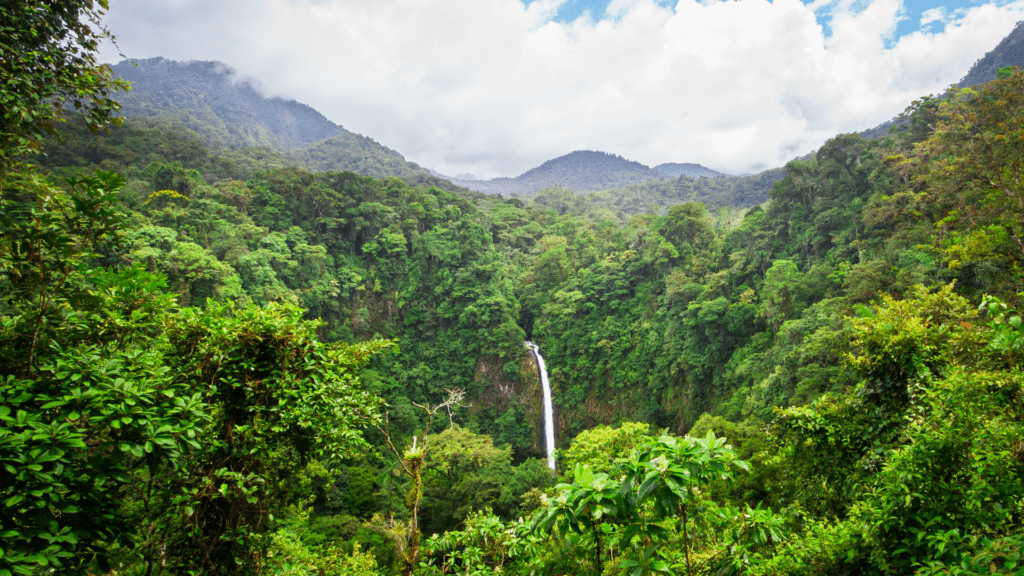
This waterfall is also one of the tallest ones in the country. It stands at a staggering 70 meters high, or 230 feet. And it plunges into a pristine pool below it. As you can imagine with such a tall waterfall, you can swim in the pool here but the current is very strong from its power. It’s still beautiful to visit, as it’s surrounded by a lush rainforest.
As you probably figured out, you’ll need to go down quite a few sets of stairs to make it to the foot of this Costa Rican waterfall – 530 steps to be exact. The stairs are well maintained, but there are a lot of them, so expect to take about 20-30 minutes. Take your time and stop when you want. There’s no rush, especially when you’re going up. Make sure to wear comfortable footwear.
With this site, there is an $18 USD entrance fee, but this gives you access to the restrooms and changing rooms at the entrance. There’s also a little café-snack bar there, in case you get hungry from climbing all those stairs. There’s also an orchid garden where they have hundreds of different species of flowers you can discover.
If La Fortuna is on your list of places to visit in Costa Rica, make sure you stop by. It’s a must-do in the area.
How to get to the La Fortuna Waterfall
The La Fortuna Waterfall is nestled in the locally-owned Ecological Reserve Fortuna Waterfall, one of the best natural reserves in Costa Rica. It’s only about 5 km from downtown La Fortuna, where many choose to set up camp to explore the area. If you’re up for it, and the weather permits, it’s a quick bike ride from the city. If not, it’s a reasonably priced Uber trip (about $10 USD) from most hotels around.
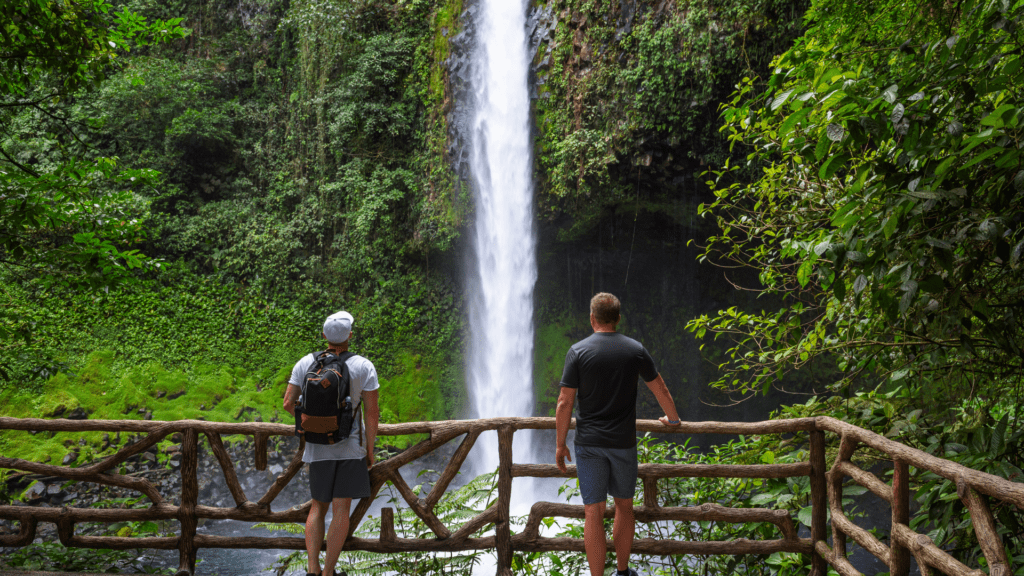
And if you’re on a road trip in Costa Rica, you surely have a car that you’ve rented, or some sweet wheels from CostaRider Campervan. There’s a smooth paved road leading to the park so no need for 4X4. Once you park, you need to go on a short 0.5 km hike down to the waterfall. We’ve already warned you about the stairs! Just take your time coming back up!
There are also a host of tours that can take you to the waterfall and to many other sites near town. If you have limited time, these are great ways to explore everything.
Where to stay near La Fortuna Waterfall
La Fortuna is a fairly popular stop on the tourist trail in Costa Rica. It’s busy year-round, which is why we would recommend you book your accommodations ahead of time if you’re eyeing a particular place.
But luckily, since it is a busy town, you also have a lot of selection in terms of budget and amenities. Here are a few places that stood out to us for offering great quality at fair prices:
- Budget-friendly: Alpha Arenal. Pura Vibra Hostel. Arenal Sloth Hostel.
- Mid-range: Selina La Fortuna. Arenal Xilopalo. Chalets Silencio del Bosque.
- Luxury: Arenal Manoa Resort & Hot Springs. Arenal Roca Lodge. Los Lagos Spa and Lodge.
What to do near La Fortuna Waterfall
La Fortuna is a popular place to set up camp for a good reason – there are a ton of fun and unique activities to do here. From hanging out in spas to adventures and adrenaline-pumping experiences, there’s something for everyone.
Here’s a short list of things to do in La Fortuna:
- Visit Arenal Volcano National Park, one of the premier national parks in Costa Rica
- Chill in the hot springs near the Arenal Volcano. You have free and paid options available
- Go to the Arenal Hanging Bridges for a canopy walk
- Go on an adventure like zip-lining, horseback riding, and ATV tours
- Hang out with locals at the El Salto swimming hole
- Go on a night tour or a sloth tour. We went for a night tour at Oasis Arenal to check out the frogs, and we loved it!
ABOUT LA FORTUNA WATERFALL
Location: Here on Google Maps
Official site
Entry cost: $18 USD. You can buy tickets online ahead of time
Opening hours: Open every day 7 am to 5 pm. Last entrance is at 4 pm.
Amenities: Bathrooms, showers, souvenir shop, orchid garden, restaurant.
Time needed: about 1-2 hours.
Swimming allowed: Yes, you can swim at bottom of the waterfall, but the water is cold and the current is strong
What to pack: Sun protection. Insect repellent. Watershoes or hiking shoes. Bathing suit. Towel. Water. Snacks. Waterproof bag.
10. Rio Celeste waterfall, a stunning waterfall in Costa Rica
Rio Celeste waterfall is one of the must-see waterfalls in Costa Rica. It’s a powerful 90-meter-tall waterfall that cascades into a mesmerizing blue-turquoise water pool. It’s located in the Tenorio Volcano National Park, one of the nicest national parks in Costa Rica. We would have loved to visit but didn’t have the chance.
There was one reason that turned us off from visiting and that was the fact that you can’t swim here. We felt like it would be such a tease to see this beautiful water and not have a chance to jump in.
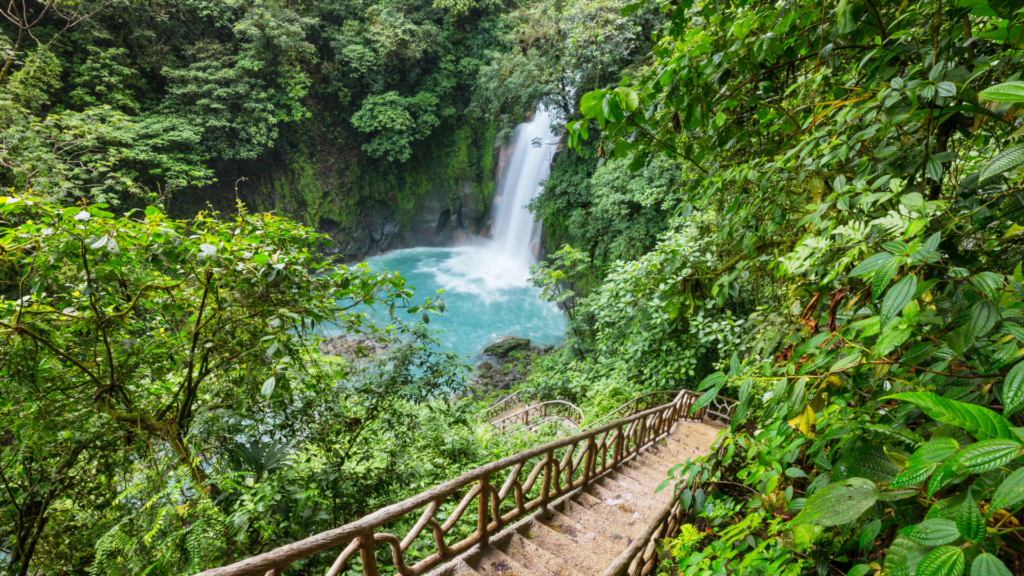
The reason the water is so blue is caused by the minerals that are present here. It’s mainly because of the volcanic minerals that flow from the volcano. However, if you listen to local legend, it says that when God painted the sky blue, he cleaned his paintbrush in the river that feeds the waterfall. This is what left behind the unbelievable color you see today. You’ll also notice this intense blue water in many of the falls near volcanos, like the Blue Falls of Costa Rica.
Although you can’t jump in the water here, the national park does have many hiking trails you can explore. The park is beautiful, located within a lush rainforest, with diverse wildlife. In fact, you have to walk about 6 km to reach the waterfall. Make sure you wear adequate shoes to get there.
We also recommend you wear adequate sun protection, bring lots of water and snacks. As with most national parks, they don’t allow you to bring single-use plastic in, so keep that in mind when packing your snacks – anything wrapped will not be allowed in.
How to get to Rio Celeste Waterfall
As we mentioned, the Rio Celeste waterfall is located in Tenorio Volcano National Park. It’s halfway between Liberia and La Fortuna. But like with most of the other national parks in the country, there is no public transportation that makes it easy and convenient to get to this Costa Rican waterfall.
Your best bet, once again, is to rent a car while you’re in Costa Rica. It’s the easiest and most convenient way to get around the country. You don’t need a 4×4 to get to this park as the roads are well paved, but if you plan on doing a longer road trip, you may want to consider renting a 4×4 if your journey will take you through rougher roads.
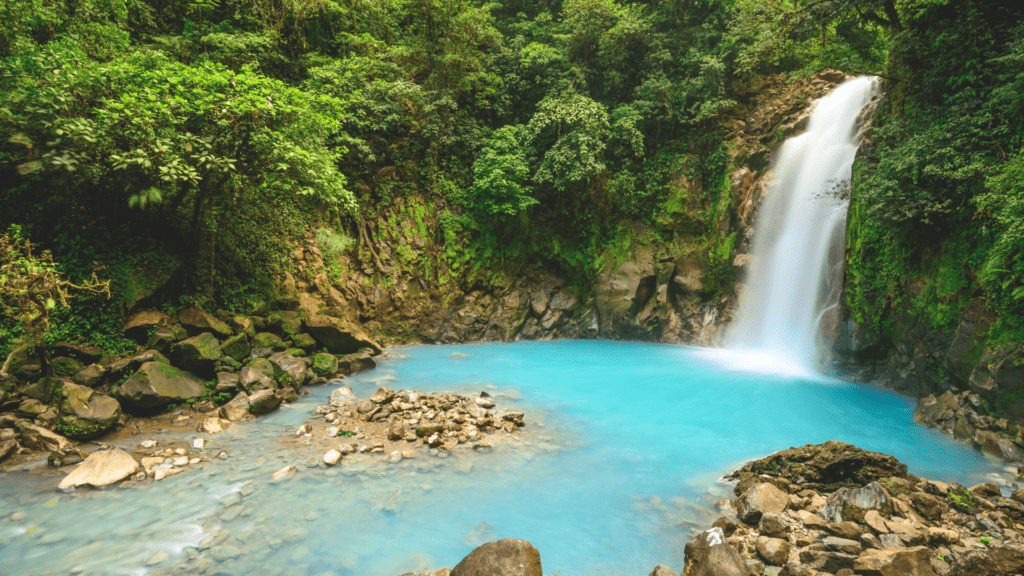
Once you get to the park, you will need to hike down to the waterfall. The trail is about 1.4 km and it’s considered to be an easy to moderate trail. If you wish to explore more of the trail, you can trek an extra 1.3 km beyond the waterfall. This will lead you to a stunning turquoise pool, bubbling hot springs, and the exact spot where the Rio Celeste goes from a murky brown hue to a dazzling electric blue.
Where to stay near Rio Celeste Waterfall
If you plan on visiting Rio Celeste waterfall, you can set up camp in so many different places. It will all depend on where you want to go next or where you’re coming from. There are a few of the towns you can stay in and check out the accommodations they have:
- La Fortuna is a great place to stay if you want a bigger city with all sorts of accommodations and amenities.
- Liberia has an international airport, so if you fly in from here, it’s another larger city with many options.
- Bijagua, San Rafael and Tapanti are smaller towns with a few different types of accommodations. Just make sure you come prepared with food, water and snacks.
What to do near Rio Celeste Waterfall
We’re sure you won’t be surprised that there’s plenty to do around Rio Celeste Waterfall. The biodiversity in Costa Rica and its various landscapes have created an infinite playground for nature lovers.
Here is just a small sample of things you can do:
- Explore the Tenorio Volcano national park with its biodiversity and multiple hiking trails.
- Go on a guided tour in the Bijagua Rainforest where you can see sloths and all sorts of other wildlife
- Check out the other waterfalls in the area, like Catarata Llanos de Cortés (details below)
- Go for a walk on the Heliconias Hanging Bridges if you haven’t visited the ones in Arenal or Monteverde
- Learn more about the indigenous Maleku community who live in the region. Some tours will give you insights into their culture, traditions, and artisanal crafts.
- If you have the time, you can check out Arenal Volcano which is a bit further away
ABOUT RIO CELESTE WATERFALL
Location: Here on Google Maps for the national park
Official site
Entry cost: $14 USD
Opening hours: Open every day. From 8 am to 2 pm. You can stay on site until 4 pm. The capacity of the park is 1,200 people per day, but only 500 people are allowed on the trail at a time. We recommend buying tickets ahead of time, especially in the busy season.
Amenities: Bathrooms and drinking water available
Time needed: about 2 hours for the waterfall. Longer if you want to explore the park.
Swimming allowed: Not at the waterfall, but you can head here to swim in the same blue waters
What to pack: Sun protection. Insect repellent. Hiking shoes. Water. Snacks. If you head to the pools nearby, bring your bathing suit & towel.
11. Llanos de Cortez Waterfall, a curtain fall in Costa Rica’s Guanacaste province
Another beautiful waterfall in Costa Rica is the Llanos de Cortez fall located near the town of Bagaces in the Guanacaste province. Standing tall at about 12 meters, this picturesque waterfall is known for its wide curtain of water and the refreshing pool at its base. Perfect for those looking to discover a stunning fall.
Although we spent 1.5 months in Playa del Coco, a town relatively close to this waterfall, we never had a chance to visit it. We were too busy scuba diving and becoming divemasters!
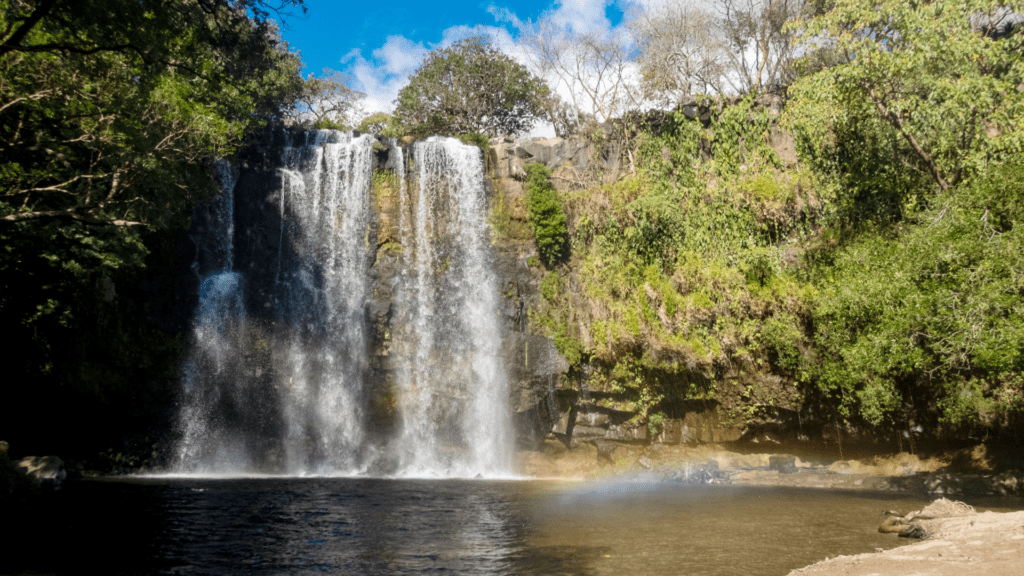
What makes this waterfall so unique is the fact that it’s a wide curtain, compared to the straight waterfalls we’re more used to seeing in Costa Rica. It’s also surrounded by lush rainforest vegetation, which creates a beautiful environment around it.
It’s fairly easy to access too. There is a really short hike that leads to it, with only a couple of steps to get to its foot. It’s totally worth it! Especially since you can actually swim at the base of this fall. The perfect way to cool down on the hot Costa Rican days.
We recommend bringing sun protection, watershoes and a waterproof bag, as well as your towel and bathing suit, so you can enjoy this waterfall.
Since it’s a fairly short hike to this fall, you can easily combine it with other activities during the day. It’s also a great waterfall to explore if you’re heading from Guanacaste to Liberia, La Fortuna or Monteverde as it’s right on the way.
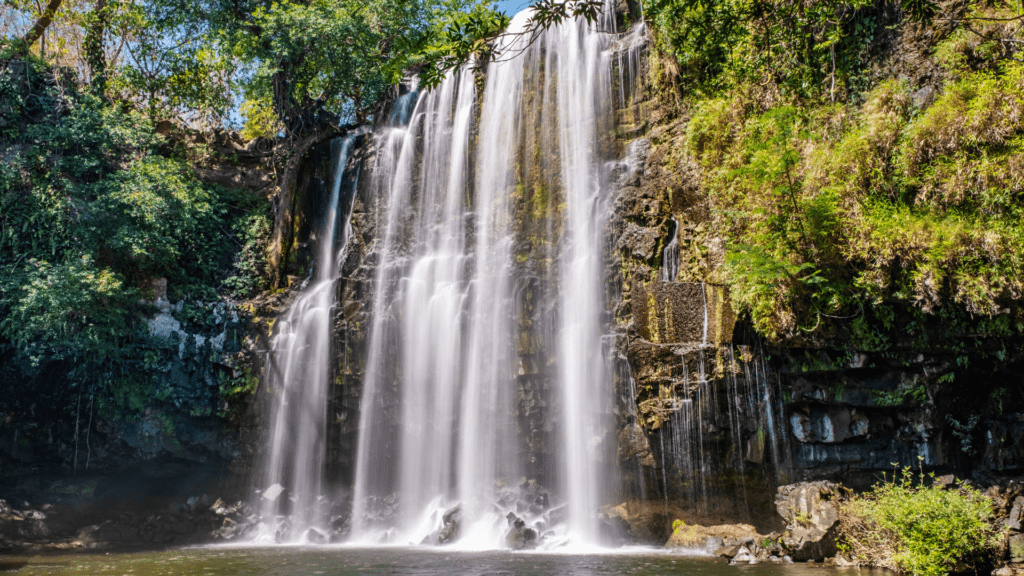
How to get to Llanos de Cortez Waterfall
As with all the waterfalls in Costa Rica, the best way to reach this one is to rent your own car and drive there as part of a longer road trip. Since this waterfall is located near a road, you don’t need a 4×4 to reach it.
If you don’t want to rent a car, there are plenty of tour providers that offer trips to Llanos de Cortez Waterfall along with other sites in the area. They all offer transportation, which makes this a no-brainer when trying to plan for fun things to do in Guanacaste.
Where to stay near Llanos de Cortez Waterfall
Like the previous Costa Rican waterfall, Llanos de Cortez is located between many different towns and cities. With a rental car or a guided tour, you can stay in a number of places and still get to this impressive waterfall.
Here are a few of the cities we can recommend:
- Bagaces is the closest town to the waterfall. It is small and there’s not much else to do here, but if you’re looking for an authentic experience, it’s the place to stay.
- Liberia is the closest city that’s a bit larger. If you need more selection and amenities, or if you landed here, this is a great place to stay.
- Playa del Cocos is a cute little town with a vibrant nightlife, good food and amazing scuba diving.
- Playa Hermosa is another beautiful beach town on the coast in Guanacaste. It’s a good location if you want to enjoy the beach and head on a day trip to this waterfall.
What to do near Llanos de Cortez Waterfall
There are plenty of fun things to do in the Guanacaste region. And what makes the Llanos de Cortez waterfall so great is that it’s fairly accessible from most towns in the province.
Here are some of the fun activities you can do near the Llanos de Cortez fall:
- Go scuba diving in Playa del Cocos. We highly recommend going with our family at Rich Coast Diving. The underwater world is so beautiful in this area.
- Explore the town of Bagaces which still has some authentic Costa Rican vibes. Discover the local markets, shops and eateries.
- Head to Rincón de la Vieja National Park, a great national park in Costa Rica known for its volcanic activity, hiking trails, and diverse ecosystems. Here, you can discover some hot springs, mud pots, and waterfalls within the park. Just note that this park’s volcano has been quite active. While we were in Cocos, it closed many times due to volcanic activity.
- Go on an adventure tour in the area. You can go zip-lining, horseback riding, or on an ATV tour.
- Visit Las Pumas Rescue Center, an animal rescue and rehabilitation center in Cañas, which houses a variety of native wildlife, including jaguars, monkeys, and birds.
ABOUT LLANOS DE CORTEZ WATERFALL
Location: Here on Google Maps
Entry cost: $7 USD
Opening hours: Open every day. There are no hours of operation, but we recommend getting there early to avoid crowds
Amenities: Bathrooms at the entrance
Time needed: about 2 hours
Swimming allowed: Yes, you can swim at bottom of the waterfall, but the water is cold
What to pack: Sun protection. Insect repellent. Watershoes. Bathing suit. Towel. Water. Snacks. Waterproof bag.
12. Montezuma waterfall, a Costa Rican waterfall worth exploring
The waterfall in Montezuma is one that we would have loved to see but didn’t have a chance to make it down so far on the Nicoya Peninsula during our time in Costa Rica. If you have a chance to make it here, we highly recommend it. We only heard great things about Montezuma as a whole.
The waterfalls in Montezuma are located in a lush rainforest near the town. It’s a set of three falls that feature a series of cascades and one main drop, as well as natural pools along the Montezuma River. The main waterfall has an impressive drop compared to the other smaller cascades.
The biggest and most popular among the trio are the lower falls which cascade 27 meters down a jagged rocky wall. The water flows into a spacious pool, the perfect spot for a refreshing swim. On the left-hand side, there are a few small rocks which are the perfect platform for those daring enough to jump into the pool (just be sure to check the water levels first!).
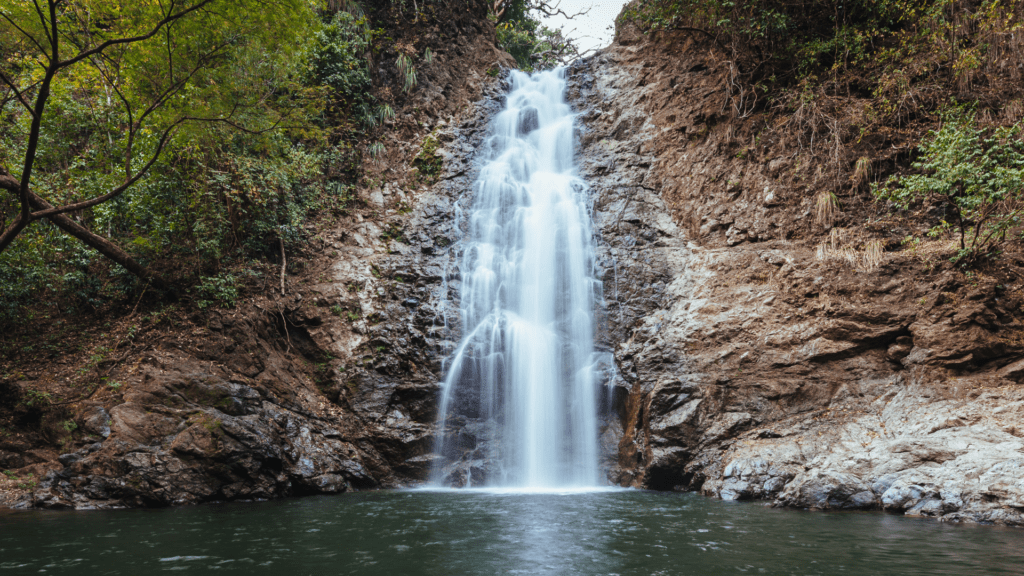
If you continue upward, you’ll get to the upper falls at the very top. Although these falls are relatively small, measuring just 4 meters, the pool below provides a serene spot for a swim, especially during the lushness of the wet season.
However, it’s the middle falls that steal the show! Since there is no real path, these falls are accessible only by clambering down rocks from the upper falls. This 12-meter waterfall is made special because of the expansive pool below it. The world’s best infinity pools have met their match! Take a dip, swim to the edge, and enjoy a unique perspective as you gaze down to the lower waterfall (safely, of course!).
The Montezuma Falls are tucked away in the jungle. The best way to access them is by following a trail south of town for approximately 20 minutes. The hike is moderately challenging. Get ready to cross the riverbed and even use a rope at certain points. If you have water shoes, it’s recommended to wear them.
Many choose to stop at the first falls, where you can take a jump in, the experience becomes more rewarding if you continue to the other two falls higher up. Just be aware that the hike becomes more demanding after the first waterfall. For those seeking an easier trek, a local tour operator has constructed sturdy stairs at the top, available for a small fee. Well worth the trek!
If you make it all the way to Montezuma, we highly recommend you take the time to visit these falls. They’re well worth it.
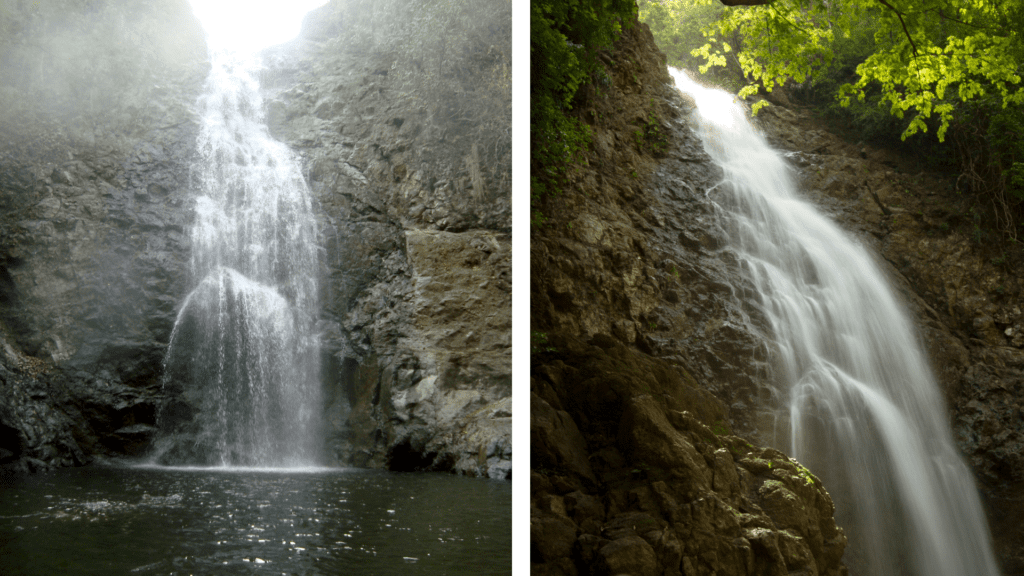
How to get to the Montezuma Waterfalls
The town of Montezuma is pretty small and quaint. It’s well worth exploring on its own. To get to the waterfall, you have to hike out about 20 minutes outside of town.
There is a free access point that involves going through the forest, following an unmarked trail. The best thing to do it to follow the river. If not, you can enter through the path created by the local company SunTrails. You’ll need to pay an admission fee, but you’ll have an actual path to follow, as well as stairs along the path.
You will need to hike to the falls, as well as hike between them, so we recommend you be in good shape and to wear appropriate shoes and sun protection.
Where to stay near Montezuma Waterfalls
Montezuma town is the best place to stay if you want to visit these waterfalls. It’s cute and charming and has all the boho vibes you’re looking for. Here, you have a lot of choice in terms of budget and amenities.
We recommend you take a look on Booking.com for hotels and rental homes, or on Hostelworld if you’re looking for more budget-friendly options or if you want to connect with other travelers.
What to do near the Montezuma Waterfalls
There’s always a ton of things to do near the Montezuma waterfalls. Here’s just a small sampling:
- Explore the town of Montezuma. It’s a charming place known for its boho vibes, vibrant art scene, electric nightlife, delicious restaurants and local markets. Make sure you also check out the local beach in town.
- During low tide, you can visit Cabuya Island and its cemetery
- Check out the Romelia Wildlife Reserve where you can see howler monkeys and different kinds of birds
- Nearby, you have access to the Cabo Blanco Absolute Nature Reserve, one of the most unique reserves in Costa Rica. Well worth exploring.
- As always, there are a ton of adventures to be had, from ziplining and canopy tours to water sports and more. Some even combine the activity with a trip to the waterfalls.
ABOUT MONTEZUMA WATERFALLS
Location: Here on Google Maps
Entry cost: There is a free entrance, but also a paid one (about $4 USD)
Opening hours: Open every day. There are no hours of operation, but we recommend starting early to avoid crowds
Amenities: None if you pick the free entrance. The other entrances do have restrooms at the main areas.
Time needed: about 3-4 hours. Depending on how long you want to hang out at the falls
Swimming allowed: Yes, you can swim at these waterfalls
What to pack: Sun protection. Insect repellent. Watershoes or hiking shoes – your feet will get wet as you have to cross the river. Bathing suit. Towel. Water. Snacks. Waterproof bag.
Fun facts about waterfalls in Costa Rica
With so many waterfalls in Costa Rica, you may be asking yourself quite a few questions. Here are some answers to the most popular questions about the different waterfalls in Costa Rica.
What is the tallest waterfall in Costa Rica?
The tallest waterfall in Costa Rica is the Catarata del Toro or the Toro Waterfall. It stands tall at 91 meters, or 300 feet, and is located in the beautiful (and somewhat unknown) region of Bajos del Toro, in the Alajuela Province of the country.
The waterfall is located about 1.5-2 hours away from San José and about 1-1.5 hours away from La Fortuna. It’s part of the same property as the Blue Falls of Costa Rica. The cost to enter the Catarata del Toro waterfall is $14 USD or $25 in a combo with the Blue Falls. Show them this coupon to get 15% off

How many Costa Rican waterfalls are there?
There are way too many waterfalls in Costa Rica. There are about 50+ just in the Bajos del Toro region, and it seems like the more people explore their properties, the more pop up.
If you’re looking to explore all the waterfalls in Costa Rica, we recommend you get started, and dedicate a whole lifetime to finding them! Good luck!
When is the best time to visit the waterfalls of Costa Rica?
The best time to visit the waterfalls of Costa Rica depends on what else you’d like to do and what region you want to explore. Costa Rica has a tropical climate, and the country experiences two main seasons: the dry season, which is from December to April, and the wet season from May to November. They both have their advantages and disadvantages.
For the dry season, you’ll be able to bunch in a lot more activities, as the weather will be nicest. Think hot sunny days and relatively no rain. However, it’s also the peak tourist season, which means higher prices and more crowds.
Also, as the name says, it is the dry season, so some waterfalls may not be as powerful or full as you would imagine. However, you may not have the issues we ran into when visiting during the wet season, which is that some waterfalls become inaccessible because of increased water levels.
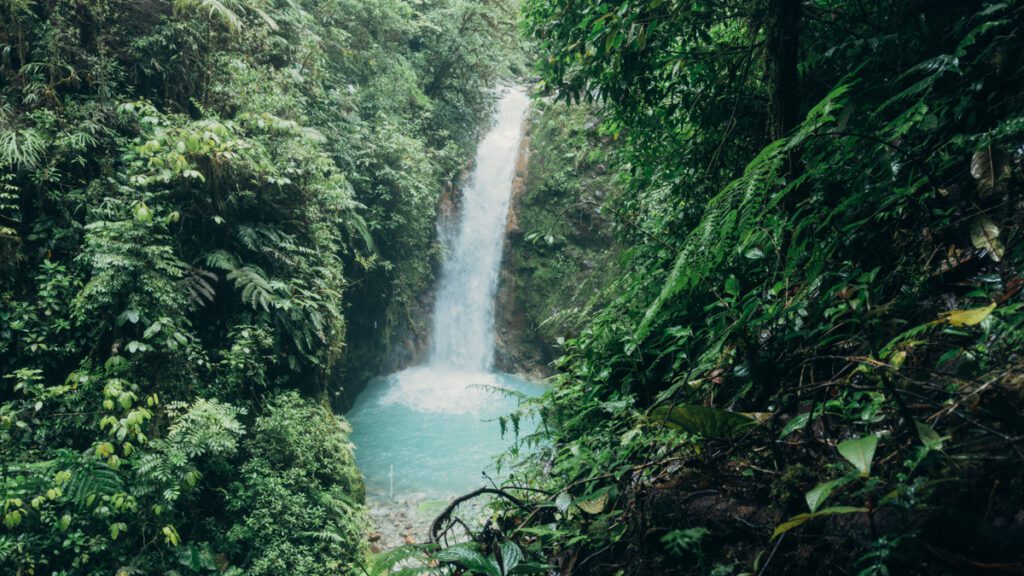
During the wet season, from May to November, there is more rainfall, but you still have sunny days, or at least, patches of the day where it’s nice and sunny. You do have to plan your activities accordingly. Usually, it rains less (or not at all), during the morning, so it’s best to explore during that time.
Waterfalls will be fuller and more dramatic and powerful during this season, but those with river crossings may be inaccessible. Also, the surrounding forest will be more lush and green, but may have more mosquitoes than you’d like!
We recommend you visit during the shoulder season, or the changing of seasons – April and May are good times when the wet season isn’t in full swing yet. And November is great because you can expect less rain and fewer crowds.
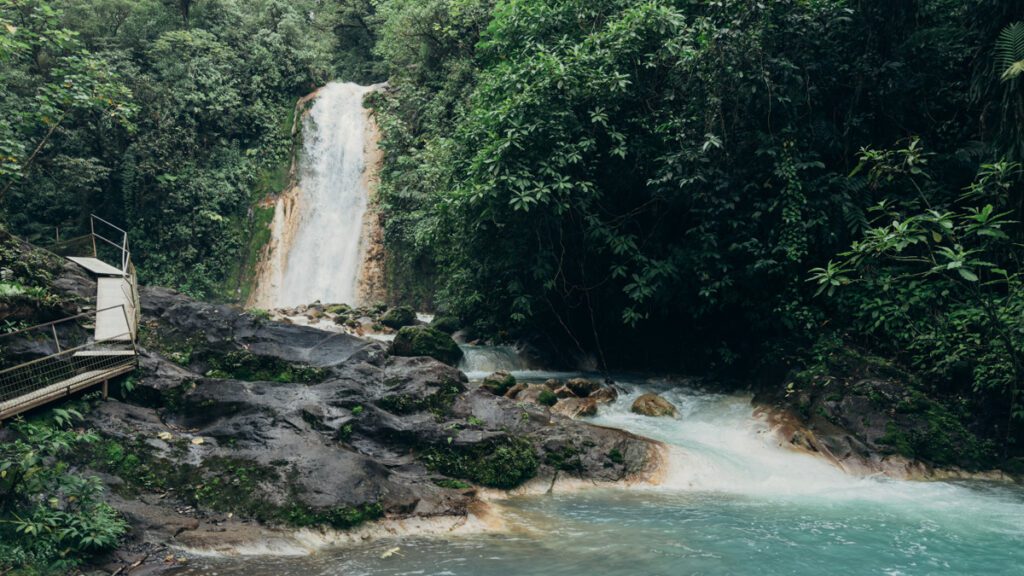
What to pack when visiting the waterfalls of Costa Rica?
Depending on whether you can swim or not, and how long the trek to the fall itself is, your packing list for visiting the waterfalls of Costa Rica will greatly depend. Although we’ve detailed the packing list for each of the falls, here is a quick reminder for all of the items to bring:
- When choosing sun protection, we highly recommend you opt for clothing that will protect you from the sun. It’s the best way to keep harmful chemicals out of the waterways. Wear a hat, long-sleeved shirt and pants.
- If you must wear sunscreen, we recommend using reef-safe sunscreen and applying it at least 30 minutes before getting in the water.
- For bug repellant, we also recommend using an environmentally-friendly version. Spray it at your car in the parking lot and avoid using it on the trails. Some of the chemicals can be harmful to the elements in the forest.
- For most of the waterfall treks, we recommend wearing hiking shoes (ideally, waterproof ones) or Chacos-type sandals (ones that have velcro straps). You often have to cross rivers or will have to hike in the rain or mud, so making sure your feet are dry and safe is your best bet!
- We also recommend bringing water shoes with you if you plan on getting in the water. The terrain is often rocky, slippery or mushy (and full of algae), so you’ll want to keep your feet comfy.
- If you have a waterproof bag, we recommend bringing it as some of these falls are quite powerful and will get your things wet.
- Finally, bring a small packable and quick-drying towel with you. If not to dry yourself, you’ll want to dry your feet before hiking on the trails again.
12 of the best waterfalls of Costa Rica to add to your bucketlist
There you have it! Your full list of amazing waterfalls to explore in Costa Rica. Sprinkled all over the country, you can choose to explore them all over a longer time frame, or concentrate your efforts and discover the best (and most accessible) ones during your one-week vacation in Costa Rica.
As a reminder, here are the top 12 waterfalls in Costa Rica
- Bajos del Toro Waterfall
- Nauyaca Waterfalls
- Uvita Waterfall
- Uvita secret waterfall
- Blue Falls of Costa Rica
- Tesoro Escondido
- Paraiso Manantiales
- Vuelta del Cañon waterfall
- La Fortuna waterfall
- Rio Celeste waterfall
- Llanos de Cortez Waterfall
- Montezuma waterfall
Let us know in the comments which ones you’re most excited to visit. Are there other waterfalls we should be adding to our list? Which ones should have made the list?
Thank you so much for reading the article all the way through!
We put a lot of time and effort into the content we create. Please like, comment and share – every action on your part helps us out tremendously and is very appreciated.
You can also help us by pinning this article for others to find.
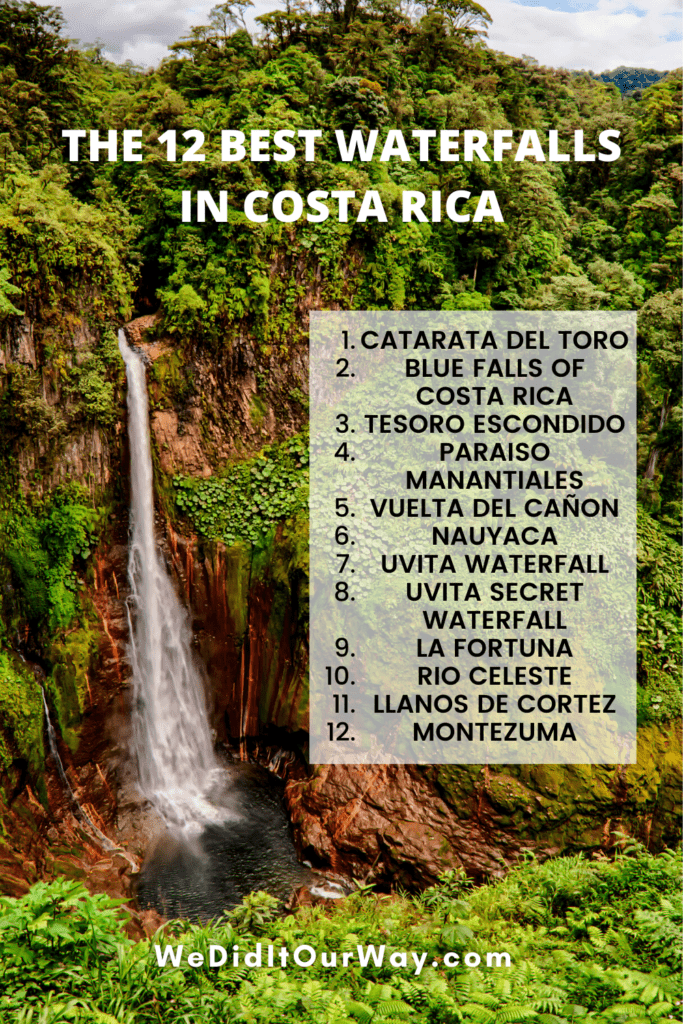
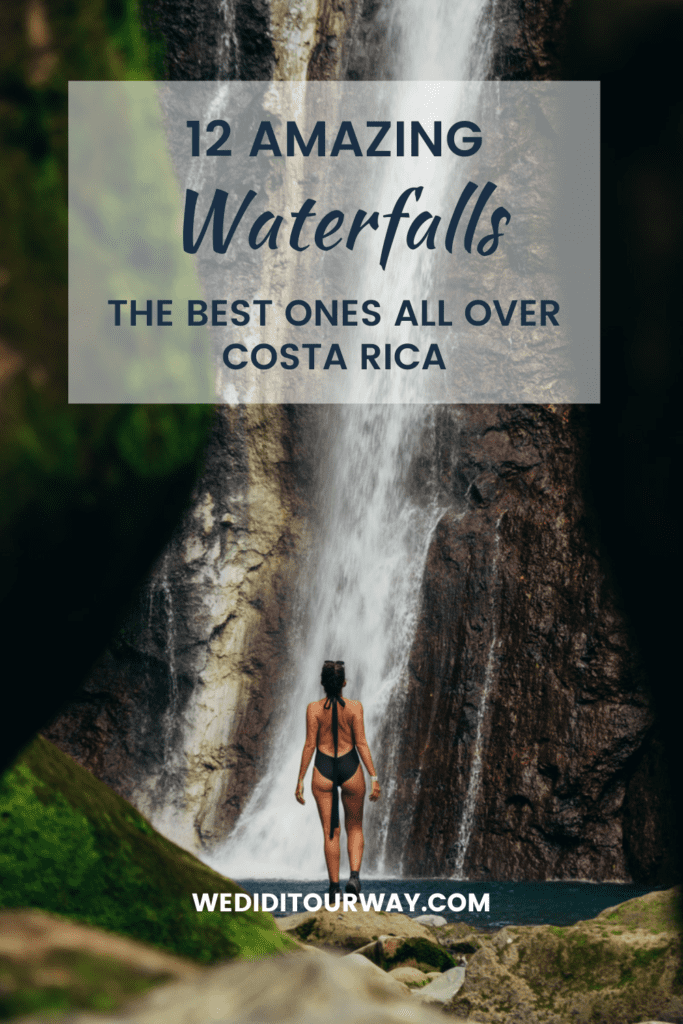
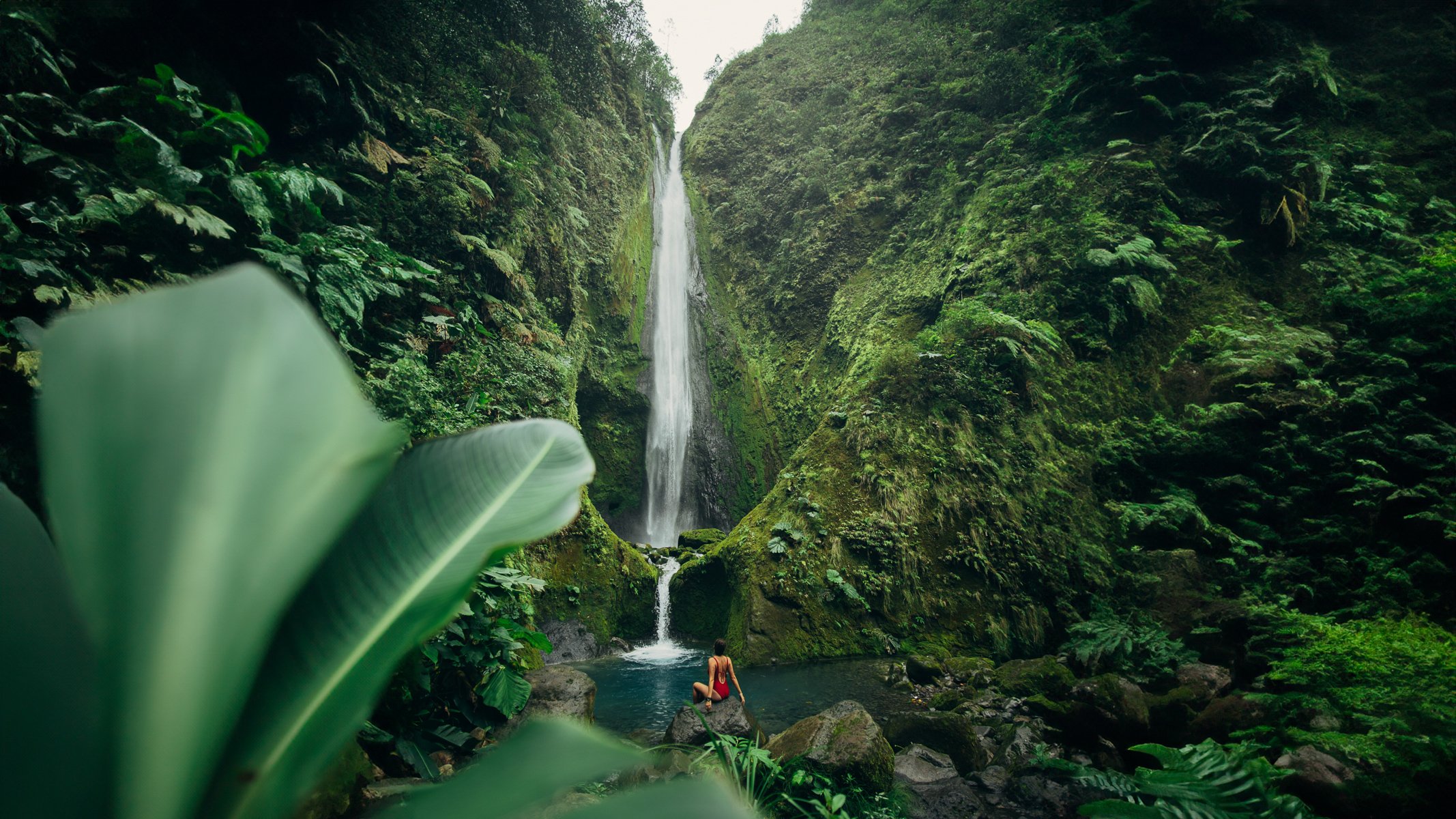
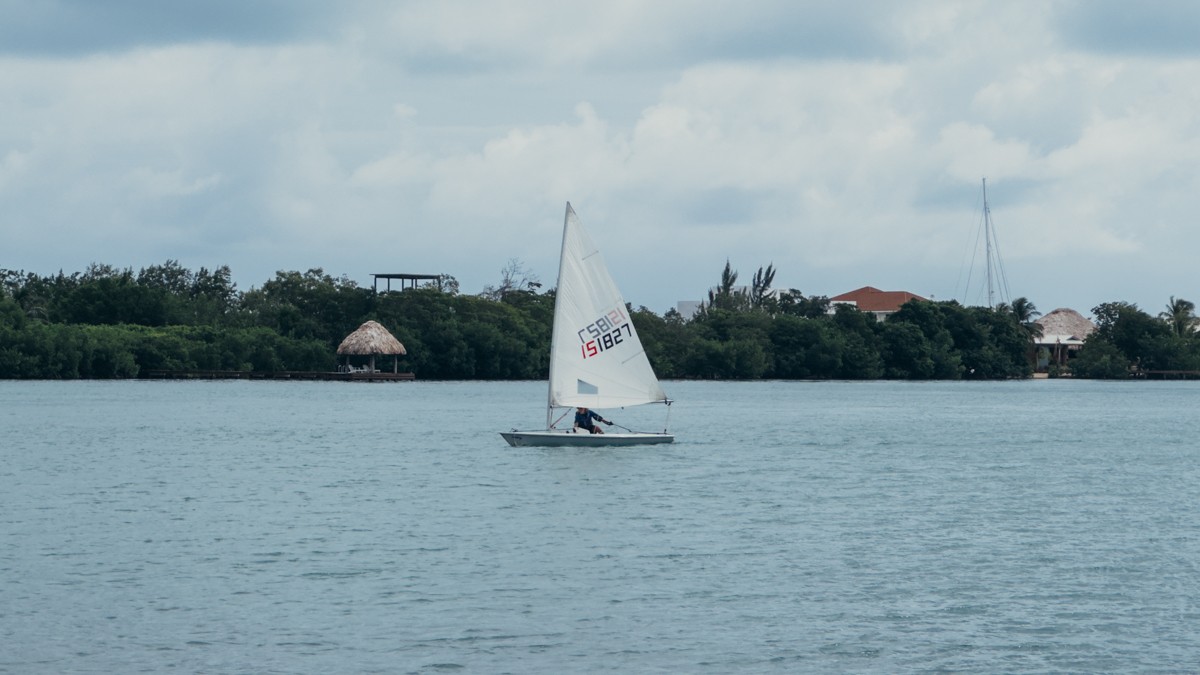

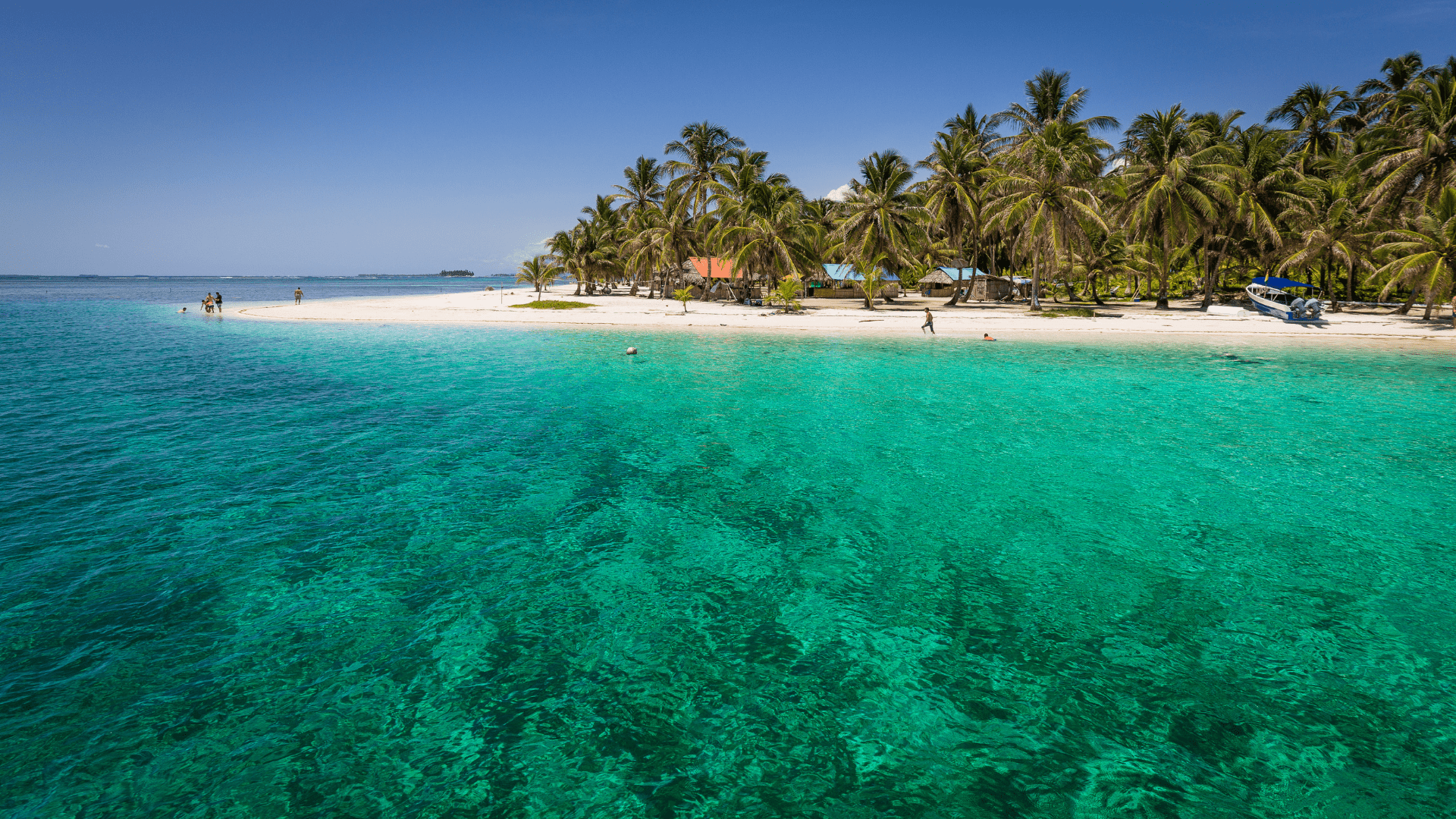
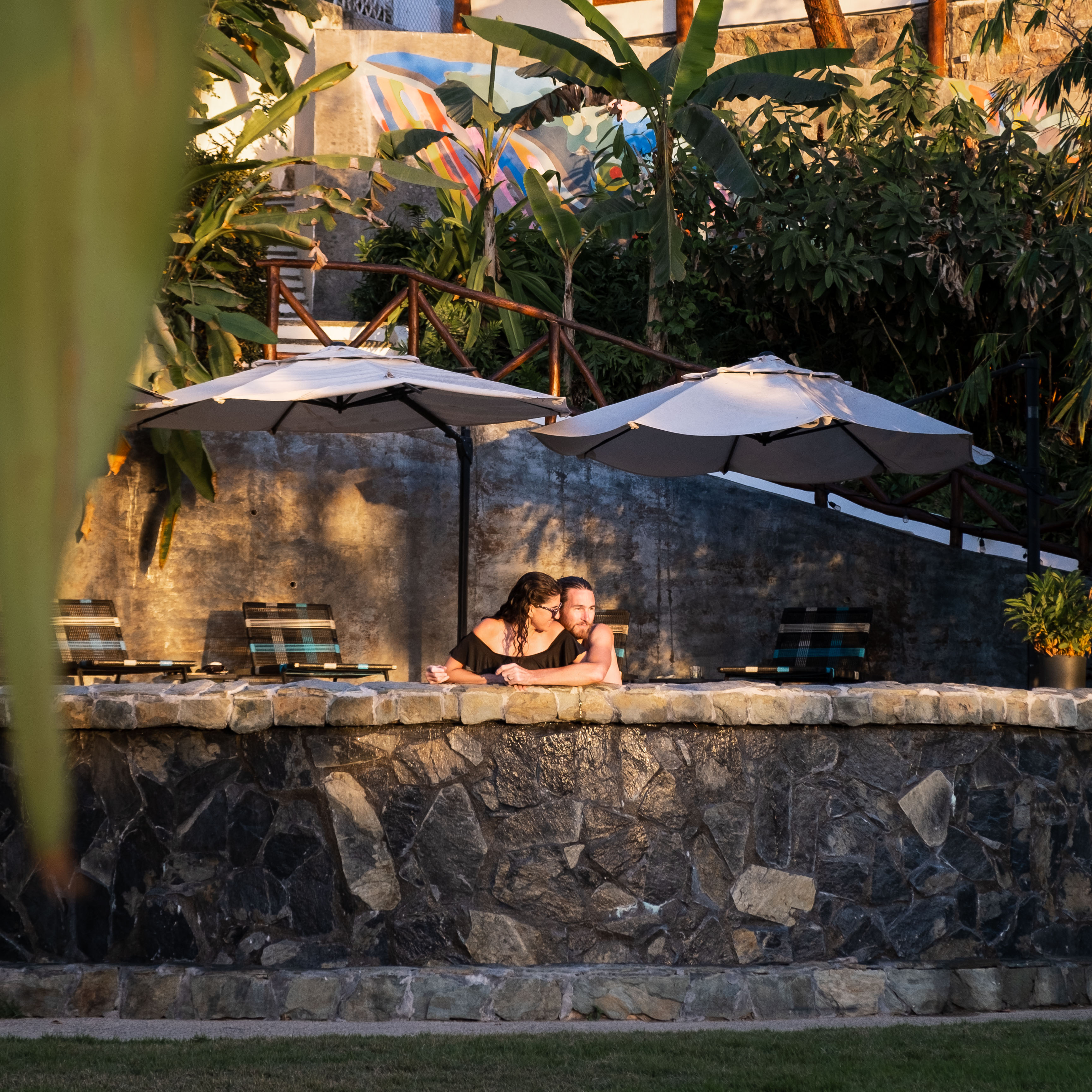


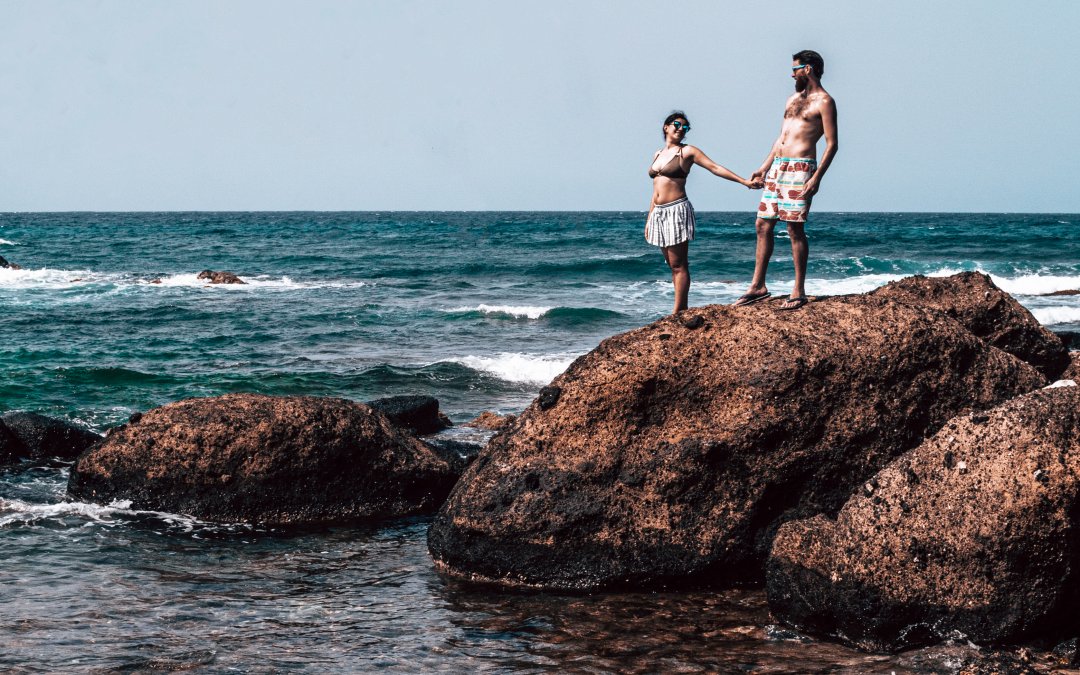
0 Comments